

Click here for a key to the symbols used. An explanation of acronyms may be found at the bottom of the page.
 Routing
Routing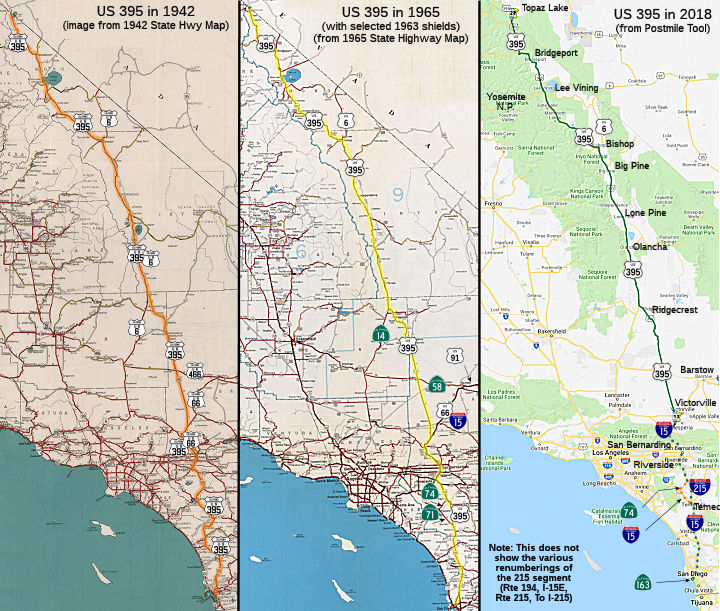 From Route 15 near Cajon Pass to the Nevada state line passing near Little
Lake, Independence, Bridgeport, and Coleville.
From Route 15 near Cajon Pass to the Nevada state line passing near Little
Lake, Independence, Bridgeport, and Coleville.
 Post 1964 Signage History
Post 1964 Signage HistoryIn 1963, Route 395 was defined as "(a) San Diego to Route 10 near San Bernardino via Temecula and passing near Riverside. (b) Route 15 near Cajon Pass to the Nevada state line passing near Little Lake, Independence, Bridgeport, and Coleville. (c) Nevada state line northwest of Reno to the Oregon state line near New Pine Creek via Alturas."
In 1969, Chapter 294 transferred the routing that was (a) to other routes. The portion from San Diego to Route 103 [which became Route 15 in 1969] was transferred to Route 163; the portion from Route 103 (present-day Route 15) to Route 71 (present-day Route 15) was transferred to Route 15; and the portion from Route 71 (present-day 15) to Route 31 (present-day Route 15) was transferred to Route 215.
Thus, the current segment (a) is the original 1963 (b).
Note that it appears that, prior to the elimination of US 395 signage in
San Diego, US 395 ran along 10th and 11th Ave from the southern end of
Balboa Park (i.e., where Route 163 and I-5 now meet) to Market Street,
where it continued W along Market Street to Harbor Drive (US 101 until it
was eliminated and replaced by I-5). The portion along Market appears to
have been cosigned with Route 94 (LRN 200). At one point, US 395 may have been extended to the Coronado Ferry which was at the end of Pacific, at least according to some San Diego Council minutes, meaning that the route wasextended
down Pacific to Seaport Village. Route 94 may have been moved from
Market to the F/G couplet in 1959.
(Source: Discussion on AARoads, 5/2019. Multiple contributors.)
There are unconstructed but adopted portions from 3 mi S of Route 18 to 7 mi S of Route 58, and from the San Bernardino County line to 8 mi S of Route 178, for 44 miles parallel to the existing traversable route.
According to Scott Parker on AARoads, there is a pathway preserved
for a US 395 freeway/expressway facility through the west end of Hesperia
and Victorville, extending north from the current US 395 split from I-15
and closely following the current US 395 alignment, but shifting from one
side (west) to the other (east) from time to time. That continues
out to where US 395 veers slightly NW south of Adelanto. Any freeway
alignment would have to arc west from the current US 395 facility to
circumvent development in that town -- but not too far, maybe a mile to a
mile and a half west. That was planned to allow as much of the
present US 395 to remain as a site for commercial activity.
Alternate alignments well to the west have also been proposed; most of
those simply skirt the west end of Victorville development by veering NW
from the I-15/US 395 interchange around the north end of Baldy Mesa and
then heading due north (and steering around the industrial parks in NW
Victorville) to align with any Adelanto bypass; all of which would rejoin
current US 395 at some point north of town. For a time, there was
thought of simply multiplexing US 395 traffic with the eastern extension
of the High Desert Corridor to interchange with I-15 north of Victorville,
but since the removal of the freeway portion from those plans, it's likely
that US 395 will, when upgraded, simply use one of the above options to
reach the current interchange in Hesperia.
(Source: Scott Parker on AARoads, "Re: CA-58 Kramer Junction Bypass", 5/30/2020)
Another planned freeway adoption was US 395 between the McGee Maintenance Station south to Crowley Lake Dam Road, adopted at the same time before the 1964 renumbering. This was built as an expressway (with one interchange); Old US 395 became "Crowley Lake Road".
 Pre 1964 Signage History
Pre 1964 Signage HistoryOriginally, a number of different state signed routes (and LRNs) corresponded to US 395. It appears that at the June 1934 meeting of AASHTO, US 395 was first created. An August 15, 1934 letter from AASHTO to the State of Oregon indicated that US 395 had just been established running from the Canadian border to San Diego. In California, by the October 1934 or 1935 signage of routes, US 395 was first signed.
The initial route of US 395 is first shown in clear detail on the 1936
State Highway Map City Insert. US 395 entered the San Diego area
southbound using the following route:
(Source: Gribblenation Blog California State Route 163; Old US Route 80/395 on the Cabrillo Freeway)
Of course, after 1964, route numbers were changed again (as detailed above), with US 395 truncated to start at I-15, and earlier portions being subsumed into the new routings of I-15, I-215, Route 74, and Route 163. Specifically, before 1964, US 395 had the following legislative routes and signing:
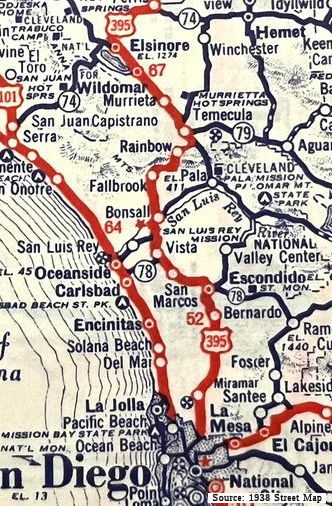 Between a point just S of the Miramar Naval Air Station and 2 mi N of Temecula:
This is present-day I-15, and was LRN 77, defined in 1931. It was signed
as Route 71 between Miramar (Miramar) and Temecula between 1934 and
1935, when US 395 was first signed. US 395 followed what is now Pomerado
Road from a point 3 miles north of the I-15/Route 163 interchange to the
interchange of Pomerado Road/I-15 at a point just south of the Lake
Hodges / San Dieguito River crossing near the southern city limits of
Escondido.
Between a point just S of the Miramar Naval Air Station and 2 mi N of Temecula:
This is present-day I-15, and was LRN 77, defined in 1931. It was signed
as Route 71 between Miramar (Miramar) and Temecula between 1934 and
1935, when US 395 was first signed. US 395 followed what is now Pomerado
Road from a point 3 miles north of the I-15/Route 163 interchange to the
interchange of Pomerado Road/I-15 at a point just south of the Lake
Hodges / San Dieguito River crossing near the southern city limits of
Escondido. 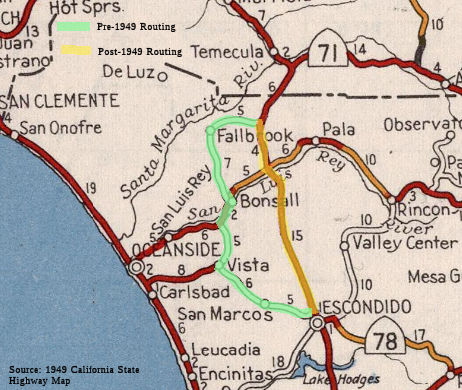 Starting in 1948, state highway maps showed an "under construction" rerouting
of US 395 between Escondido and Temecula that essentially took a
straight line routing between a point S of Rainbow (where current
"Old 395" crosses I-15 to meet Mission Ave) and Escondido. This
routing was completed by 1949.
Starting in 1948, state highway maps showed an "under construction" rerouting
of US 395 between Escondido and Temecula that essentially took a
straight line routing between a point S of Rainbow (where current
"Old 395" crosses I-15 to meet Mission Ave) and Escondido. This
routing was completed by 1949. Between 2 mi N of Temecula and Riverside: The original routing was part of LRN 77 (future Route 71) and LRN 78 (future Route 74, I-215 between Perris
and Riverside). Note that the portion between Elsinore and Temecula was
both LRN 77 and LRN 78, until the 1950 rerouting of LRN 78 to the
present-day I-215 routing between Temecula and Perris. LRN 78 was,
defined in 1931. For a time it was signed as I-15E. This was part of
Route 194 between 1974 and 1982. Note that, until 1950, US 395 was
routed along the route of present-day I-15 from Temecula to the junction
with present-day Route 74, then along present-day Route 74 to "D" Street
in Perris, and then up "D" Street along present-day I-215. This is shown
on some of the older maps. US 395 signage started in 1935 for the dogleg route.
The US 395 designation was moved to a direct routing in 1952-1952
between Temecula and Perris (present-day I-215) upon completion of
construction of the new highway. The older dogleg routing through
Elsinore remained as Route 71 (eventual I-15) and Route 74. Note that
the routing from Perris to Riverside was originally signed as part of
Route 740.
Between 2 mi N of Temecula and Riverside: The original routing was part of LRN 77 (future Route 71) and LRN 78 (future Route 74, I-215 between Perris
and Riverside). Note that the portion between Elsinore and Temecula was
both LRN 77 and LRN 78, until the 1950 rerouting of LRN 78 to the
present-day I-215 routing between Temecula and Perris. LRN 78 was,
defined in 1931. For a time it was signed as I-15E. This was part of
Route 194 between 1974 and 1982. Note that, until 1950, US 395 was
routed along the route of present-day I-15 from Temecula to the junction
with present-day Route 74, then along present-day Route 74 to "D" Street
in Perris, and then up "D" Street along present-day I-215. This is shown
on some of the older maps. US 395 signage started in 1935 for the dogleg route.
The US 395 designation was moved to a direct routing in 1952-1952
between Temecula and Perris (present-day I-215) upon completion of
construction of the new highway. The older dogleg routing through
Elsinore remained as Route 71 (eventual I-15) and Route 74. Note that
the routing from Perris to Riverside was originally signed as part of
Route 740.
In 1915, the road through Temecula was first constructed, spawning
businesses such as the Swing Inn, known as Mother's Cafe and
Alesandro's Place in its earliest days, and other eateries like Mrs.
L.M. Hall's Temecula Lunch Rooms, the B-Bar-H Cafe and the Rite-Spot.
The two-lane concrete road, built by Riverside County, ran from Perris
through Murrieta and into Temecula along Jefferson Avenue and Front
Street before heading up the grade toward Rainbow, according to Phil
Brigandi's book, "Temecula at the Crossroads of History." Eventually
designated US 395, that road and others like it were built to make
automobile travel more practical and comfortable. In 1949, US 395 was
rerouted out of the business area and up to about where I-15 runs
today. There were fears in Temecula that the bypass would severely
damage local merchants. A study by the California Division of Highways
showed business at the five cafes in Temecula decreased more than 18
percent between 1949 and 1950. However, that same study showed that
throughout the entire county the cafe business was also down about 18
percent in the same period.
(Source: San Diego Union Tribune, 7/28/2005)
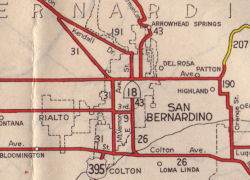 Between Riverside and San Bernardino: The route was
cosigned as US 91/US 395, and was LRN 43 (defined in 1931). This is
currently I-215, although for a time it was signed as I-15E. This was
part of Route 194 between 1974 and 1982. As the 1944 map shows, US 395
entered into Colton, where the routing dropped the cosigning with Route 18, and continued N along Waterman as LRN 31.
Between Riverside and San Bernardino: The route was
cosigned as US 91/US 395, and was LRN 43 (defined in 1931). This is
currently I-215, although for a time it was signed as I-15E. This was
part of Route 194 between 1974 and 1982. As the 1944 map shows, US 395
entered into Colton, where the routing dropped the cosigning with Route 18, and continued N along Waterman as LRN 31. East of the Route 203 interchange, "Old Highway" takes a routing parallelling Mammoth Creek for a bit and crossing it a bit northeast of the current US 395 expressway. It serves as a connection to several local roads, including a forest route along Antelope Springs Road. However, it is unclear if Old Highway directly connects with existing US 395 (Mapquest shows it as doing so; MSN's map service does not).
An "Old State Highway Road" parallels Route 120/US 395 from south of West Portal Road on the east side of Grant Lake all the way north to Oil Plant Road south of Lee Vining. (This is shown on Mapquest and on Compass's maps.)
 Status
StatusIn November 2011, the first workshop for the "Historic Highway 395 Corridor Study" project, also known as the Jefferson Avenue Corridor project, was held in Murrieta. The 16-mile arterial corridor is proposed to parallel the west side of I-15 where old US 395 used to travel. It would extend from Rancho California Road along Jefferson Avenue through the cities of Temecula and Murrieta, continuing along Palomar Street and Mission Trail through the cities of Wildomar and Lake Elsinore, and continuing along East Lakeshore Drive to Main Street in Lake Elsinore. Additional information may be found at http://www.highway395corridorstudy.org/.
Note: The bulk of the information on the High Desert Corridor is discussed with Route 138.
The SAFETEA-LU act, enacted in August 2005 as the reauthorization of TEA-21, provided the following expenditures on or near this route:
Jct I-15 to Jct Route 14 near Inyokern
In July 2007, the CTC relinquished right of way in the city of Hesperia, at Outpost Road, consisting of reconstructed and relocated city street. The City, by relinquishment cooperative agreement dated April 16, 2007, waived the 90-day notice requirement and agreed to accept title upon relinquishment by the State.
US 395 Expressway / Realignment
The SAFETEA-LU act, enacted in August 2005 as the reauthorization of TEA-21, provided the following expenditures on or near this route:
There are currently plans to realign US 395 near the cities of Oak Hills, Hesperia, Victorville, Adelanto and incorporated areas of San Bernardino County. This is based off of a draft EIR. The plan is to realign US 395 from the I-15/US 395 interchange (approx SBD R3.981) to Farmington Road. The proposed US 395 Realignment Freeway/Expressway corridor to be evaluated is located either on existing US 395 or west of existing US 395, through the cities of Oak Hills, Hesperia, Victorville, Adelanto and incorporated areas of San Bernardino County. The entire proposed project length is approximately 45.0 miles long. There are four alternatives currently being considered:
In June 2016, it was reported that state financial
issues have resulted in all STIP funding being removed from the 395
Expressway Project which would widen Route 395. But Caltrans will continue
to seek funding to complete widening of existing Route 395, according to
Caltrans spokeswoman Terri Kasinga.
(Source: Mass Transit, 6/6/2016)
In June 2021, it was reported that the CTC approved $1.3 million for a
project on US 395 in Hesperia for the construction of a 4-foot median,
with the addition of rumble strips and standard shoulders. The portion of
US 395 in Hesperia is a north-south roadway that stretches from I-15 north
to the California Aqueduct in Victorville (~ SBD R3.99 to SBD 6.843).
(Source: Victorville Daily Press, 6/29/2021)
US 395 Widening - I-15 to Route 18 (~ SBD R3.99 to SBD 11.22)
In March 2015, the CTC approved for future consideration of funding a project in San Bernardino County that will construct operational efficiencies on US 395 from 0.16 mile north of the junction of US 395 and I-15 in the city of Hesperia to approximately 1.80 miles south of Desert Flower Road in the city of Adelanto. The project is programmed in the 2014 State Transportation Improvement Program. The total estimated cost is $55,191,000 for capital and support. Construction is estimated to begin in Fiscal Year 2016-17. The scope, as described for the preferred alternative, is consistent with the project scope programmed by the Commission in the 2014 State Transportation Improvement Program.
In July 2018, it was reported that this phase has received environment clearance, and is on hold pending construction funding.
In January 2022, the CTC approved including "Widen
sections of US 395 from two to four lanes between I-15 and Palmdale Road
in the Cities of Hesperia and Victorville " in the list of projects for
the Coronavirus Response and Relief Supplemental Appropriations Act of
2021 (CRRSAA). The CRRSAA Program guidelines require regions submit a
project list for allocation by the Commission prior to the obligation of
funds. Under CRRSAA, the funds may be used for a broad range of surface
transportation purposes listed in Section 113(b) of Title 23 of the U.S.
Code and are meant to “prevent, prepare for, and respond to
coronavirus.” Specifically, CRRSAA allows states to cover revenue
losses, which is important given that California’s State-generated
transportation revenues have declined by about $1.5 billion due to the
pandemic. Additionally, CRRSAA allows the funds to be used for
preventive and routine maintenance; operations; personnel; salaries;
contracts; debt service payments; and availability payments; as well as
transfers to public tolling agencies. At the March 2021 Commission
meeting, the CTC approved the CRRSAA funding distribution and regional
apportionments. The CRRSAA allocation for this project was $9,960,528 .
(Source: January 2022 CTC Minutes, Agenda Item
2.5k)
On March 16, 2022, the CTC approved the 2022 State
Transportation Improvement Program, which included the following project:
PPNO 3019L "Rt 395 Freight Mobility, Rt 15-Rt 18, Ph2 (SB1)", 18,647,000
in FY 25-26.
(Source: "2022 State Transportation Improvement
Program", Adopted March 16, 2022)
US 395 Median Buffer Project (08-SBd-395, PM R4.8/7.6)
In June 2021, the CTC amended the following project
into the 2020 SHOPP: 08-SBd-395 4.8/7.6 PPNO 3017R ProjID 0821000009 EA
08-1L890. US 395 In and near Hesperia, from north of Joshua Street to
Eucalyptus Street. Construct four-foot median, standard shoulders,
and rumble strips and upgrade guardrail. PA&ED $1,302K; PS&E
$1,635K; R/W Sup $931K; ⊘Con
Sup $1,757K; ⊘R/W Cap $1,664K;
⊘Const Cap $7,652K TOTAL
$14,941K. Begin Const: 5/2/2025. It is also approved the following
pre-construction allocation: 08-SBd-395 4.8/7.6. PPNO 3017R; ProjID
0821000009; EA 1L890. US 395 In and near Hesperia, from north of Joshua
Street to Eucalyptus Street. Construct four-foot median, standard
shoulders, and rumble strips and upgrade guardrail. (Concurrent amendment
under SHOPP Amendment 20H-008; June 2021.) Allocation: PA&ED
$1,302,000 (24-25).
⊘: Phase
not programmed.
(Source: June 2021 CTC Agenda/Minutes, Agenda Item
2.1a.(1a) #10; June 2021 CTC Agenda, Agenda Item 2.5b.(2a) #26)
In June 2023, the CTC approved the following project
for future consideration of funding: 08-SBd-395, PM R4.8/7.6 US 395
Median Buffer Project. Construct a four-foot median buffer and
maintain existing centerline rumble strips and install shoulder rumble
strips. The project also proposes to widen the existing roadbed and
upgrade an existing culvert on US 395, in San Bernadino County. (MND)
(PPNO 3017R) (SHOPP). The project is located on US 395 from PM R4.8 to PM
7.6, in San Bernardino County. The Department proposes to construct
four-foot median, standard shoulders, rumble strips, and upgrade
guardrail. In addition, a drainage culvert and down drain facility needs
widening due to the widening of the roadbed. The project is currently
programmed in the 2022 SHOPP for a total of $14,941,000, which includes
Right of Way (Support and Capital) and Construction (Support and Capital).
Construction is estimated to begin 2024-25. The scope, as described for
the preferred alternative, is consistent with the project scope as
programmed by the Commission in the 2022 SHOPP. A copy of the MND
has been provided to Commission staff. The project will result in less
than significant impacts to the environment after mitigation. The
following resource areas may be impacted by the project: desert tortoise,
nesting birds, bats, rare plants, burrowing owl, and Mojave ground
squirrel. Avoidance, minimization, and mitigation measures will reduce any
potential effects to the environment. These measures include, but are not
limited to, environmentally sensitive area fencing, pre-construction
surveys, and environmental awareness training. As a result, a MND was
completed for this project.
(Source: June 2023 CTC Agenda, Agenda Item 2.2c.(1) Item 8)
US 395 Widening - Route 18 to Chamberlaine Way (SBD 11.2 to SBD 16.3)
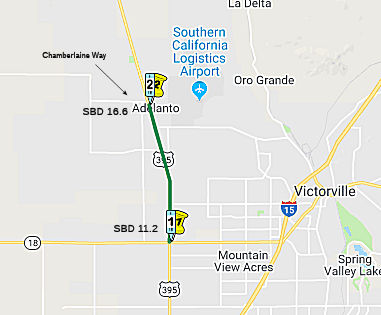 In March 2015, the CTC allocated $5,550,000 to SANBAG for US 395 Interim
Widening. In Hesperia, Victorville and Adelanto. Widen US 395, from Route 18 to Chamberlaine Way (08-SBd-395, PM 11.2/16.6), from two lanes to four
lanes and construct left-turn channelization at various intersections.
In March 2015, the CTC allocated $5,550,000 to SANBAG for US 395 Interim
Widening. In Hesperia, Victorville and Adelanto. Widen US 395, from Route 18 to Chamberlaine Way (08-SBd-395, PM 11.2/16.6), from two lanes to four
lanes and construct left-turn channelization at various intersections.
In August 2016, it was reported that Measure I funding
included widening of US 395 from Mojave Drive (~ PM SBD 12.633) south to
Star Street (~ PM SBD 12.385), which is expected to cost $4.1 million,
with 63.5 percent of the funding required from development impact fees.
(Source: VV Daily Press, 8/26/2016)
The 2018 STIP, approved at the CTC March 2018 meeting, appears to allocate $9.333M for PPNO 0260J Widening, Rt 18-Chamberlaine Way (~ SBD 11.22 to SBD 16.742).
In July 2018, it was reported that work was scheduled
to begin in Fall 2018 on nearly $60 million in improvements to the busy
stretch of highway between Route 18 and Chamberlaine Way — a major
freight traffic route and passenger corridor that connects economic
centers, recreation areas, cities and rural communities. These
improvements will widen that portion of the highway by providing two lanes
in each direction, and includes the addition of turn pockets and signals
at key intersections along the corridor. The start of construction is the
culmination of years of planning and securing the funds needed to make it
happen, including nearly $18 million in voter-approved Measure I funds,
the half-cent sales tax measure for San Bernardino County. The San
Bernardino County Transportation Authority (SBCTA) is partnering with the
California Department of Transportation (Caltrans) to see this and
subsequent phases of the 395 improvement project through completion. Tthe
Victorville-to-Adelanto leg is just one of three phases of an overall US 395 plan for which state and federal funds have been secured. Those future
phases — from Interstate 15 to State Route 18 and from Chamberlaine
Way to Desert Flower Road — have received environmental clearance
and should begin once those additional funds are obtained. It is
anticipated to be open in Fall 2020, with project closure in late 2021.
(Sources: VV Daily Press, 6/24/2018; U.S.395
Phase 1 Project Page; June 2018 Project Fact Sheet)
In August 2018, the CTC approved an allocation of
$33,625,000 for the locally-administered multi-funded Senate Bill 1 (SB 1)
Trade Corridor Enhancement Program (TCEP)/State Transportation Improvement
Program (STIP) Route 395 Widening from Route 18 to Chamberlaine Way
project (PPNO 0260J), in San Bernardino County.
(Source: August 2018 CTC Agenda Item 2.5s.(9))
The 2020 STIP, approved at the March 2020 CTC meeting,
continues programmed funding for PPNO 0260J Rt 395 Widening, Rt
18-Chamberlaine Way (TCEP).
(Source: March 2020 CTC Agenda, Item 4.7, 2020 STIP
Adopted 3/25/2020)
US 395 Widening - Adelanto (SBD 15.95) to Desert Flower Road (~ SBD 21.086) and beyond to SBD 36.40
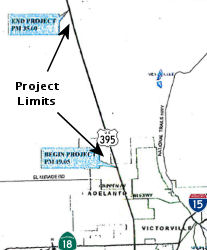 In May 2012, the CTC approved for future consideration of funding a project in San Bernardino
County that will widen the median and shoulders along US 395 (PM 15.95 -
PM 36.40), install rumble strips, resurface the roadway, and widen the
following intersections to accommodate the new width of US 395: Colusa
Road. Desert Flower Road. Purple Sage Street, Shadow Mountain Avenue, Sun
Hill Ranch, and Princess Pat Mine. The project is programmed in the 2010
State Highway Operation and Protection Program (SHOPP). The total
estimated project cost is $55,460,000 for capital and support.
Construction is estimated to begin in Fiscal Year 2012-13. The scope, as
described for the preferred alternative, is consistent with the project
scope programmed by the Commission in the 2010 SHOPP.
In May 2012, the CTC approved for future consideration of funding a project in San Bernardino
County that will widen the median and shoulders along US 395 (PM 15.95 -
PM 36.40), install rumble strips, resurface the roadway, and widen the
following intersections to accommodate the new width of US 395: Colusa
Road. Desert Flower Road. Purple Sage Street, Shadow Mountain Avenue, Sun
Hill Ranch, and Princess Pat Mine. The project is programmed in the 2010
State Highway Operation and Protection Program (SHOPP). The total
estimated project cost is $55,460,000 for capital and support.
Construction is estimated to begin in Fiscal Year 2012-13. The scope, as
described for the preferred alternative, is consistent with the project
scope programmed by the Commission in the 2010 SHOPP.
In July 2018, it was reported that this phase (at least the portion between Adelanto and Desert Flower Road) has received environment clearance, and is on hold pending construction funding.
In August 2018, the CTC approved $15,171,000 in SHOPP funding for San
Bernardino 08-SBd-395 35.5/39.1 US 395 Near Adelanto, from 1.0 mile south
of Kramer Hills to 2.6 miles north of Kramer Hills. Outcome/Output: Widen
median and shoulders and construct rumble strips. This project will
increase safety and reduce the number and severity of collisions.
(Source: August 2018 CTC Agenda Item 2.5f.(3) Item
14)
Kramer Hills Widening
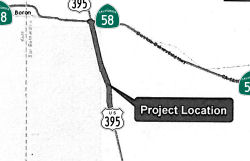 In October 2015, the CTC approved for future
consideration of funding a project in San Bernardino County that will
construct a median barrier, widen shoulders, and install rumble strips on
US 395 near the community of Kramer Hills. The project is programmed in
the 2014 State Highway Operation and Protection Program. The total
estimated cost is $40,657,000 for capital and support. Construction is
estimated to begin in Fiscal Year 2017/18. The scope, as described for the
preferred alternative, is consistent with the project scope programmed by
the Commission in the 2014 State Highway Operation and Protection Program.
A copy of the MND has been provided to Commission staff. (Approx SBD
38.633 to SBD 46.207)
In October 2015, the CTC approved for future
consideration of funding a project in San Bernardino County that will
construct a median barrier, widen shoulders, and install rumble strips on
US 395 near the community of Kramer Hills. The project is programmed in
the 2014 State Highway Operation and Protection Program. The total
estimated cost is $40,657,000 for capital and support. Construction is
estimated to begin in Fiscal Year 2017/18. The scope, as described for the
preferred alternative, is consistent with the project scope programmed by
the Commission in the 2014 State Highway Operation and Protection Program.
A copy of the MND has been provided to Commission staff. (Approx SBD
38.633 to SBD 46.207)
In August 2017, the CTC allocated $28,597,000 for San Bernardino 08-SBd-395 39.0/45.9 US 395: Near Adelanto, from 2.5 miles north of Kramer Hills to Route 58. Outcome/Output: Widen median and shoulders and construct rumble strip to reduce the number and severity of traffic collisions. Future consideration of funding approved under Resolution E-15-56; October 2015.
In August 2019, it was reported that construction crews
are working on two projects south of the intersection of US 395 with Route 58 where they’re widening shoulders to eight feet, placing
centerline and shoulder rumble strips and reinstalling two passing lanes
south of Kramer Junction, going both ways. Striping will also be widened
from four to six inches on the entire stretch of US 395 from I-15 to the
Kern County line. In some sections, Caltrans has also put in channelizers
— thin fiberglass paddles — that will help deter crossing the
double-yellow lines. The three projects should be completed by the end of
the year at an overall cost about $35.5 million. Some of that total is
funded with Senate Bill 1 funds, the so-called “gas tax,”
according to a Caltrans document.
(Source: Victor Valley Daily Press, 8/19/2019)
In December 2020, as a side-effect of the Kramer Hills Widening and the
Route 58 bypass, it was announced that long time US 395 business
Astroburger has closed its doors for good. It will be raised for a new
ARCO station. Although the building had become dilapidated over the
years with weeds in the parking lots, lack of signage, and unsure-of
hours, it still drew a crowd on Sunday afternoons for visitors returning
from mountain and or desert trips, enjoying Astroburger for the milkshakes
and all-American fast food. Astroburger’s heyday was during the
early formation of the 1970s Space Shuttle program at nearby Edwards Air
Force Base, where many of the early shuttle components were built
and tested. The opening last year of the long-awaited Route 58 bypass, a
four lane freeway, that now avoids the once dreaded Four Corners stop
signals, and the sometimes hour-long back up for Mojave to Barstow run,
was the death of the iconic drive-in. Pressure has been put on the Larrs
Family, who owns most of the Four Corners property, to bring additional
business off the new freeway into the small business area to support their
leasees, especially in light of the new super-sized Love’s Truck
Stop being built one exit west, in Boron. The possible four-drive-thru
site project will also eventually eliminate the Pottery Shop on the
Northwest corner of Old Hwy 58 and US 395. ARCO is the first business
committing to the project. (An older ARCO station found itself on the dead
end road to nowhere with the opening of the bypass, It closed last year.)
The large antique store, known for its old gas station signs, will not be
part of the project and will remain.
(Source: 100.7 KIBS FM, 12/2/2020)
In California City, there is a proposal for a new road that would run from Muroc Junction following the alignment of Rosamond Boulevard at the Edwards Air Force Base north gate. The road would curve to connect with California City Boulevard at the curve just south of the city. It would then proceed north to connect with 20 Mule Team Parkway, which would be paved all the way to its current connection with US 395. This will provide a faster connection between Edwards AFB and the Naval Air Weapons Center.
Jct Rte 14 (near Inyokern) to N end of Bishop
Olancha Bypass (09-Iny-395 29.2/41.8)
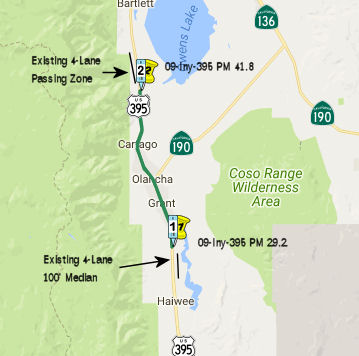 In 2007, the CTC did not recommend funding construction
of the Olancha and Cartago Expressway ($107,600K total cost; $59,000K
requested) from the Corridor Mobility Improvement Account (CMIA). However,
the minutes from the 11/08 meeting of the Inyo County Local Transportation
Commission discussed the five options for US 395's realignment (either
expansion or a movement west). The main problem is the proximity of the LA
Aqueduct.
In 2007, the CTC did not recommend funding construction
of the Olancha and Cartago Expressway ($107,600K total cost; $59,000K
requested) from the Corridor Mobility Improvement Account (CMIA). However,
the minutes from the 11/08 meeting of the Inyo County Local Transportation
Commission discussed the five options for US 395's realignment (either
expansion or a movement west). The main problem is the proximity of the LA
Aqueduct.
In February 2016, it was reported that discussions of
the Olancha Bypass continue. The Caltrans preferred alternative is a
bypass of the community that has Olancha residents in an uproar. Although
the bypass alternative seems to be the much safer option, Olancha
residents don't want to lose the business highway traffic brings into the
already struggling town. Olancha residents claim the bypass alternative is
unfair because the other towns on the US 395 corridor in Inyo country
(Bishop, Big Pine, Independence, Lone Pine) got to keep the highway
running through town. If the bypass alternative is chosen the current
alignment will be turned into a combination of a local road and an
extension of Route 190, a major state route taking year round visitors to
Death Valley National Park. The bypass routing would be to the west, close
to the base of the Sierras, which would give travelers a beautiful view.
The extension of Route 190 would be to the south, through Olancha,
terminating at an intersection with the newly aligned US 395.
(Source: Inyomono395 @ AAroad, February 2016)
In August 2017, the CTC approved for future consideration of funding 09-Iny-395 PM 29.2/41.8 Olancha/Cartago Four-Lane Project: This project in Inyo County will construct two new lanes (one new lane in each direction) on a portion US 395 near the town of Olancha. The project will increase safety and the Level of Service. The project is not fully funded. The project will be funded from State Transportation Improvement Program (STIP) funds and is currently programmed in the 2016 STIP for an estimated $16.6 million Right of Way (capital and support). Construction is estimated to begin in Fiscal Year 2020-21. The scope, as described for the preferred alternative, is consistent with the project scope programmed by the Commission in the 2016 STIP. A copy of the FEIR has been provided to Commission staff. Resources that may be impacted by the project include community impacts, noise, water quality, air quality, cultural resources, paleontological resources, hazardous waste, aesthetics, and biological resources. Potential impacts associated with the project can all be mitigated to below significance. As a result, an FEIR was prepared for the project. Note that this appears to be distinct from the once-proposed Olancha Bypass.
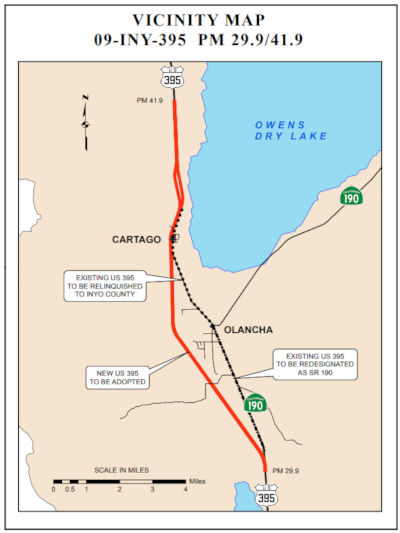 In January 2018, the CTC approved a request from the
California Department of Transportation’s (Department) to adopt US 395 in Inyo County from INY 29.9 to INY 41.9 as a controlled access
highway, redesignate a segment of superseded US 395 as Route 190 and, upon
construction completion of the new controlled access highway, relinquish
the remaining portion of the superseded US 395 to Inyo County. The
Department proposes to adopt this 12.14 mile section of US 395 to
construct a new expressway within the adoption limits, which will improve
safety for the traveling public, raise the level of service, and provide a
continuous four-lane facility in Inyo County. A final Environmental Impact
Report/Environmental Assessment (EIR/EA) prepared pursuant to the
California Environmental Quality Act and the National Environmental Policy
Act was approved by the Department on March 7, 2017 and by the Federal
Highway Administration (FHWA) on May 26, 2017. The Department approved a
project report on June 27, 2017 recommending construction of the new US 395 expressway on a new alignment and redesignation of a portion of the
superseded segment as Route 190. The remaining portion of the superseded
highway will be relinquished to Inyo County after project construction
completion. Later maps indicated that the relinquished section of US 395
may be signed as BUSINESS US 395.
In January 2018, the CTC approved a request from the
California Department of Transportation’s (Department) to adopt US 395 in Inyo County from INY 29.9 to INY 41.9 as a controlled access
highway, redesignate a segment of superseded US 395 as Route 190 and, upon
construction completion of the new controlled access highway, relinquish
the remaining portion of the superseded US 395 to Inyo County. The
Department proposes to adopt this 12.14 mile section of US 395 to
construct a new expressway within the adoption limits, which will improve
safety for the traveling public, raise the level of service, and provide a
continuous four-lane facility in Inyo County. A final Environmental Impact
Report/Environmental Assessment (EIR/EA) prepared pursuant to the
California Environmental Quality Act and the National Environmental Policy
Act was approved by the Department on March 7, 2017 and by the Federal
Highway Administration (FHWA) on May 26, 2017. The Department approved a
project report on June 27, 2017 recommending construction of the new US 395 expressway on a new alignment and redesignation of a portion of the
superseded segment as Route 190. The remaining portion of the superseded
highway will be relinquished to Inyo County after project construction
completion. Later maps indicated that the relinquished section of US 395
may be signed as BUSINESS US 395.
Within the proposed adoption limits, US 395 is currently a two-lane undivided conventional highway. It traverses gently sloping terrain at elevations between 3,600 and 3,900 feet as it passes through the communities of Olancha and Cartago. Olancha is sparsely developed with a few businesses, a post office, and one service station. Cartago is located about three miles north of Olancha and is primarily a residential community. There are a few businesses and residences adjacent to the highway, but in general, the highway corridor is rural in nature. This project will connect the four-lane divided expressway segments at both ends of the adoption limits.
The existing highway generally consists of two 12-foot lanes and 8-foot paved shoulders within 100 feet of right of way. There are no shoulder improvements such as curb, gutter or sidewalk throughout this section of the highway. There is no median and approximately 50 percent of the highway is barrier striped to prevent passing. There are undivided passing lanes for both northbound and southbound traffic north of Cartago. The posted speed limits vary from 65 mph outside of the communities to 55 mph within the communities. In addition to the intersection with Route 190, there are six other public road connections and numerous other private roads and access points to the existing highway within the project limits.
Due to the numerous access points and limited sight distances along US 395, passing zones are limited. There is also a mixture of slower recreational and commercial vehicles, local residential and business traffic, and faster through traffic. The limited passing opportunities and mixed traffic has led to queuing within the communities, driver frustration, and frequent unsafe passing maneuvers. In 2006, shoulders were widened and the posted speed limit reduced within the communities, but the fatal accident rate remained at 1.29 times the statewide average. This section of highway is currently operating at Level of Service (LOS) D and is projected to fall to LOS E within the 20-year planning period.
The proposed route adoption will allow the Department to construct the expressway on a new alignment. It will eliminate traffic congestion and significantly increase safety for the traveling public by separating opposing traffic, removing passing restrictions, and controlling access points. Finally, the new expressway will provide route continuity on US 395 and will complete the construction of four-lanes throughout the US 395 corridor in Inyo County.
A draft project report was approved in September 2010 to evaluate five alternatives. Their environmental impacts were evaluated in an Initial Study/Environmental Assessment circulated end of 2010. Focused studies performed for the preferred alternative determined that mitigation of cultural impacts to insignificant levels may not be possible. As a result, the environmental document was elevated to a Draft Environmental Impact Report/Environmental Assessment (EIR/EA) which allowed the Department to discuss the potential cultural impacts and evaluate the preferred alternative. The Draft EIR/EA was circulated from August to October 2015, after which the preferred alternative was selected.
The portion of the existing highway between the intersection with Route 190 and the southern intersection with the new expressway is proposed to be redesignated as Route 190. A concurrent Commission’s action to approve the redesignation of this portion of US 395 as Route 190 is on the January 2018 Commission agenda. This action will reestablish the terminus of Route 190 at US 395. The remaining portion of the superseded highway between the intersection with Route 190 and north of the community of Cartago will be relinquished to Inyo County after project completion. The superseded highway will continue to provide a local route that preserves the existing uses and access along the existing corridor. The project will also construct or reconstruct a couple other county roads, all of which will be relinquished to Inyo County.
This project has been jointly funded by the Inyo County
Local Transportation Commission, Mono County Local Transportation
Commission, Kern Council of Governments, and the Interregional Improvement
Program. Due to shortfalls in the programming available for the 2016 State
Transportation Improvement Program (STIP), the Construction Capital and
Construction Support components were deprogrammed. Funding for the
Construction Capital and Construction Support components have been
restored in the proposed 2018 STIP. The estimated total cost of the
project, including construction and right of way costs escalated to the
year of construction, is $138,819,000. The project is scheduled to start
construction in September 2020.The Department and Inyo County have agreed
with the public road openings proposed for the new expressway and intend
to execute a Controlled Access Highway Agreement following the
Commission’s approval of this route adoption. Currently, the
Department and Inyo County are negotiating the terms of the relinquishment
agreement. Inyo County has agreed in principle to accept the
relinquishment of the facilities.
(Source: CTC Agenda, January 2018, Agenda Item 2.3a(1))
The 2018 STIP, approved at the CTC March 2018 meeting, appears to restore funding from this, moving the total from $11,420K to $41,487K, including an additional $23,495K in FY21-22, presumably for construction. The project is near Olancha and Cartago, south of the Los Angeles Aqueduct Bridge to south of the Ash Creek Bridge. Widen 2 lane conventional highway to 4 lane expressway. There also appears to be additional funding for this from the Kern and Mono County shares.
In March 2020, the CTC approved the 2020 STIP, which
appears to continue the programmed funding for PPNO 0170 "Olancha-Cartago
4-lane expressway (RIP 25%)" in both Inyo and Kern counties. This funding
includes $17,992K in prior year funding, and 23,495K in FY21-22 for Inyo
and $4,498K in prior year funding and 9,295K in FY21-22 for Kern. It also
included PPNO 0170 Olancha-Cartago 4-lane expressway (IIP 40%), in the
Interregional portion of the STIP with no change in programming: $17,992K
in prior year funding. and $49,615K in FY21-22.
(Source: March 2020 CTC Agenda, Item 4.7, 2020 STIP
Adopted 3/25/2020)
In April 2020, it was reported that Caltrans was in the
final stages of design and right-of-way acquisition for the
Olancha-Cartago 4-Lane project. The project will upgrade 12.6 miles of the
current two-lane highway to a four-lane access-controlled expressway. The
new alignment will begin four miles south of Olancha to four miles north
of Cartago and will close the gap between the existing four-lane sections
to the north and the south. Preconstruction activities include utility
verification and relocation, vegetation removal and/or relocation, staking
the new alignment, installing desert tortoise exclusion fence, and other
various preliminary items. This $83 million-dollar project is jointly
funded by Inyo and Mono Counties’ Local Transportation Commissions,
Kern Council of Governments, and Caltrans with State Transportation
Improvement Program funds. Project completion is tentatively scheduled for
late 2023.
(Source: Sierra Wave Media)
In October 2020, the CTC was given notice of a proposed
amendment to the US 395 – Olancha and Cartago 4-lane Expressway
project in Inyo county (PPNO 0170) (EA 21340/21341) (INY 29.200/41.800),
to separate out a portion of the mitigation work ( $2,920,000 $3,058,000)
into a new project, identified as the Olancha and Cartago Expressway
Desert Tortoise Exclusion Fence project (PPNO 0170B). This project had
extensive and complex environmental challenges, which culminated in
successfully achieving environmental clearance in June 2017, after efforts
for over 10 years, with an Environmental Impact Report/Environmental
Assessment. During the design phase, the archaeological
pre-mitigation work needed to be completed. A separate
archaeological pre-mitigation project for $5,000,000 was programmed for
this project, which was allocated by the Commission in May 2018. In
addition, avoidance and mitigation measures are required to protect the
Desert Tortoise. The avoidance and mitigation fencing are required
to be completed prior to pre-construction activities such as geo-tech
investigations, geo-tech boring, geo-archeology coring, archeological data
recovery and utility relocation. In addition, the fence must be in
place prior to commencing construction activities such clearing and
grubbing vegetation, culvert installation, roadway construction and bridge
construction. The funding for the fencing was identified and budgeted in
the Right of Way (R/W) component. R/W funding for the project was
programmed in 2014 and was done as a lump sum allocation per STIP
Guidelines. It had been the standard practice to execute the
construction of the fencing through a service contract with R/W funds.
However, in December 2018, there was a policy change that no longer allows
R/W capital funds to be used in that manner, and a contract is necessary
to construct the fencing requiring the work to be split and delivered
separate from the main project construction. The Desert Tortoise Exclusion
Fence project cost is $2,920,000 $3,058,000.
The proposal is to separate the cost and scope of the fence from the
construction capital of the main project. This separate project would be
able to begin ahead of the major construction contract. With a separate
project to address the fencing, it reduces the risk of delays to the main
project. The current estimated construction capital cost of the main
project remains on budget. The right of way cost estimate for the
main project is currently under budget with potential cost savings to be
reported at time of construction allocation. By having the fencing in
place, allows the construction to proceed without delays. This change to
separate out the fencing cost, from the construction capital, allows the
project to proceed, mitigates the risk of delays since the original
process of implementing as a service is no longer feasible. It
should be noted that the new alignment can be cleared at any time after
the fence is constructed, and the Desert Tortoise fencing would not be the
critical path for the prime contractor. In December 2020, the amendment
(with a corrected amount for the fencing) was voted upon.
(Source: October 2020 CTC Agenda, Agenda Item
2.1b.(1); December 2020 CTC Agenda, Agenda Item 2.1a.(2))
In December 2020, the CTC approved an allocation of
$3,058,000 for the State-Administered STIP Olancha and Cartago Expressway
Desert Tortoise Exclusion Fence project (PPNO 0170B ProjID 0914000036 EA
21341) (INY 29.200/41.800), on the State Highway System, in Inyo County,
programmed in 2021-22. These funds are for installation of Desert Tortoise
Exclusion Fencing.
(Source: December 2020 CTC Agenda, Agenda Item
2.5c.(5))
In May 2021, the CTC approved an allocation of
$92,966,000 for the State-Administered STIP Olancha and Cartago Expressway
project (PPNO 0170), on the State Highway System, in Inyo County,
programmed in 2021-22. The allocation is divided as follows: $83,116,000
from the Budget Act of 2020, Budget Act Items 2660-301-0042 and
2660-301-0890 for construction and $9,850,000 for construction
engineering. Allocation time extensions for other projects programmed
within the current, fiscal year have allowed for sufficient capacity to
become available to fund this advanced project allocation. Details:
09-Iny-395 29.2/41.8. PPNO 09-0170; ProjID 0900000030; EA 21340. Olancha
and Cartago Expressway. US 395 near Olancha and Cartago, south
of the Los Angeles Aqueduct Bridge to south of the Ash Creek Bridge.
Widen 2 lane conventional highway to 4 lane expressway. (Future
consideration of funding approved under Resolution E-17-53; August 2017.)
(Source: May 2021 CTC Agenda, Agenda Item 2.5c.(5))
In July 2022, it was reported that ground was broken on
the Olancha-Cartago 4-Lane Project. The Olancha-Cartago 4-Lane Expressway
project will pass west of the town of Olancha and the Los Angeles
Aqueduct. Once the alignment crosses Olancha Creek, the project will cross
the Los Angeles Aqueduct and continue north through Cartago along the
existing highway to meet up with the four-lane section of US 395 to the
north of Cartago. The northbound and southbound lanes will be separated by
a 100-foot unpaved median. As of July 2022, crews were placing rebar on
the footing for the bridge abutments and wingwalls on the south side of
the Los Angeles aqueduct; excavation for the bridge abutments on the south
side of the Los Angeles Aqueduct was completed in June 2022 and excavation
begun for the abutments on the north side. Drainage system installation
continues throughout the project.
(Source: District 9 Project Page, July 2022)
In May 2023, it was reported that workers working on
the Olancha-Cartao project have found buried human remains on the
project's stretch of US 395. These bonds were missed by earlier
archaeological surveys required to start construction of the $69.7-million
Caltrans project to convert 12.6 miles of US 395 from a two-lane road to a
safer four-lane expressway. Tribal leaders say, more than 30 tangled human
skeletons had been unearthed at the site near the Inyo County community of
Cartago, many of them adorned with artifacts: glass beads, abalone shells
and arrowheads. As a result, tribal historic preservation officers are
demanding that the California Department of Transportation halt
construction and realign the project to avoid the gravesites. The project
got off to a rocky start when it was proposed in 1997, with many tribal
leaders warning that nearly every slope, sage plain and shoreline in the
region held evidence of Indigenous people who knew it as a kingdom of
irrigated villages and plentiful game surrounded by canyons and crags
sculpted by storms and flash floods. Caltrans in April offered a proposal
to curve the disputed section of highway around the burial site. But it
wouldn’t move the highway far enough away to satisfy tribal leaders,
who are calling for a clearance of at least half a mile to a mile. The
tribes insist they are not against the highway improvement project. The
problem is that it was approved for construction, they say, without their
consultation. Finally, in mid to late May 2023, Caltrans announced that it
has “halted all construction activities in the area in
question,” including its search for human remains.
(Source: Los Angeles Times, 5/9/2023)
In June 2023, the CTC approved for future consideration
of funding 09-Iny-395, PM 29.2/41.8 Olancha/Cartago Four-Lane Project.
Widen and realign US 395 to four lanes, in Inyo County. (FEIR Addendum)
(PPNO 0170) (STIP). The project is located on US 395 from postmile 29.2 to
postmile 41.8, in Inyo County. The Department proposes to widen a two-lane
conventional highway to a four-lane expressway. The project is currently
programmed in the 2020 STIP for a total of $134,827,000, which includes
Construction (Support and Capital). Construction began 2021-22. The scope,
as described for the preferred alternative, is consistent with the project
scope as programmed by the Commission in the 2020 STIP. A copy of the FEIR
has been provided to Commission staff. The Commission approved the project
for future consideration of funding on August 17, 2017, under Resolution
E-17-53. Since the approval of the 2017 FEIR, CEQA addendums were prepared
to address the modifications to utility relocations, the addition of fiber
optic utility infrastructure as part of the Broadband Middle Mile Network
effort, and the addition of a Global Navigation Satellite System (Real
Time Network) survey station. Additionally, on September 22, 2020, the
western Joshua tree gained protection under CESA as a candidate species to
be listed as threatened or endangered. The Department subsequently
completed Addendums to the FEIR pursuant to CEQA. The Department has
approved this project for construction. This approval and Addendums will
satisfy the environmental requirements for this stage of the planning
process.
(Source: June 2023 CTC Agenda, Agenda Item 2.2c.(2) Item 9)
In June 2023, the CTC approved a request for an
additional $7,800,000 in Construction Support for the STIP Olancha and
Cartago Expressway project on US 395, in Inyo County, to complete the
construction contract. This project (09-Iny-395 29.2/41.8, PPNO 09-0170;
ProjID 0900000030; EA 21340) is located on US 395, in and near Olancha and
Cartago, from south of the Los Angeles Aqueduct Bridge to south of the Ash
Creek Bridge, in Inyo County. The project will convert the two-lane
conventional highway into a four-lane expressway. In March 2012, the
project was programmed for $5,900,000 in Construction Support in the STIP,
$3,103,000 from the Interregional Improvement Program (IIP) and $2,797,000
from the Regional Improvement Program (RIP), for allocation in Fiscal Year
2020-21. In March 2014, the project was amended to increase the programmed
amount to $8,100,000 in Construction Support, $4,260,000 from the IIP and
$3,840,000 from the RIP based on the refinement of the resources needed
when the Project Approval and Environmental Document phase was
completed. In March 2018, the project was further amended to
increase the programmed amount to $9,850,000 in Construction Support,
$5,180,000 from the IIP and $4,670,000 from the RIP, based on the
escalation of the resources to the year of allocation. In May 2021, the
project was allocated for $9,850,000 in Construction Support in the STIP,
$5,180,000 from the IIP and $4,670,000 from the RIP. In October
2021, the project was awarded, and construction began in January 2022,
with a planned 500 working days. The remaining funds are currently
at $1,836,000 in Construction Support. The project is 40 percent
complete with 235 working days remaining. The planned Construction
Contract Acceptance is scheduled for August 2024. The Department is
requesting supplemental funds in the amount of $7,800,000 in Construction
Support from the IIP, to complete the construction contract. Total revised
amount $84,310,100.
(Source: June 2023 CTC Agenda, Agenda Item 2.5e.(9))
The project realized cost increases due to
previously undiscovered archeological resources and storm issues that
caused staging delays, regrading of areas, and rework of drainage.
These events and changes have resulted additional work. The project is
located in an environmentally sensitive area for biology and
tribal/archeological resources. Extensive tribal coordination, outreach,
and consultation have been and continue to be conducted throughout project
development and construction. Unanticipated finds of archaeological
and tribal cultural resources, including burials, necessitated additional
surveys, monitoring, treatment, avoidance measures, and security services
which increased costs. These additional resources amount to $2,700,000.
Due to the extent of newly discovered archeological resources, the
northbound lanes were realigned to avoid the resources, resulting in
redesign and additional utility work. These additional resources
amount to $900,000. Adding to the delay were the severe Winter storms in
2023 that caused damage to the drainage systems and surrounding rough
grading and work stoppages, resulting in delays in critical path items and
delaying the project by three months. An emergency project is underway,
under a Director’s Order, to repair the storm damage that occurred
to drainage systems in the area and on this project. The contractor
on this project was brought in to perform the emergency storm damage
repair work. The resource mitigation and the emergency damage repair work
will delay paving and related construction activities. An additional 175
working days will be needed to complete the project. This will
result in the project being completed in three construction seasons as
opposed to the two seasons that were originally planned. The project will
need additional resources in the amount of $4,200,000 to complete the
remaining activities to close out the project.
(Source: June 2023 CTC Agenda, Agenda Item 2.5e.(9))
Manzanar Improvements (approx INY 67.69)
In October 2004, the CTC considered adoption of 2.6 kilometers (1.6 miles) of Controlled Access Highway for Route 395 from 2.9 kilometers (1.8 miles) south of Mazourka Canyon Road to 0.3 kilometers (0.2 mile) south of Mazourka Canyon Road in Inyo County. Currently, this segment of Route 395 is a two-lane conventional highway crossing generally level terrain. Cross-section consists of two standard 3.6 m (12 ft) lanes with predominantly non-standard 1.2 m (4 ft ) shoulders, where 3 m (8 ft) is standard. At the southern limit of the adoption, the route will connect to the recently approved Manzanar four-lane divided section (Resolution HRA-04-02 approved August, 2004). This segment south of Independence was not included in the Manzanar adoption, as it was an integral part of a possible Independence bypass alternative and subject to various alignment considerations. This bypass alternative had less than a 3% approval at public hearings and was ultimately rejected for the recently approved 4-lane improvement project through Independence. Current and twenty year projected Level of Service (LOS) for the existing facility is ‘D’, congested. The current and twenty year LOS for the proposed project is ‘A’, free flowing. The majority of the property through which this segment of the route passes is owned by the Los Angeles Department of Water and Power, with little development adjacent to the existing or proposed right of way south of Independence. The route adoption proposes a controlled access highway on predominantly existing alignment from the northern end of the Manzanar four lane section adopted in August, 2004, to a point 0.3 kilometers (0.2 miles) south of Mazourka Canyon Road, at Independence. Construction is currently scheduled for FY 2007-08, based on programming in a 2004 STIP.
The four lane project between Lone Pine and/through Independence is nearly completed as of August 2010. The last portion is around Manzanar where a new bridge is being completed for the southbound alignment; the northbound alignment is pretty much intact. The new alignment in Manzinar leaves a stretch of the old alignment as a frontage road, and the only connection from the new US 395 to the frontage road is at Manzanar Reward Rd. This means all of US 395 from Inyokern to Conway Summit is four-lane expressway except for the piece through Olancha which is unlikely to be upgraded anytime soon. The segment was completed in October 2010.
In January 2011, the CTC vacated right of way in the county of Inyo along Route 395 at the Manzanar National Historic Site, consisting of superseded highway right of way no longer needed for State highway purposes.
In Independence (roughly INY 73.35), Caltrans is attempting to widen US 395. However, trees are in the way, according to an article in the LA Times. Specifically, Caltrans engineers say 100 trees are standing in the way of plans to widen a stretch of the route in Independence from two to four lanes and line it with about 400 feet of sidewalks. The project, they say, would improve safety and the flow of vehicles on the rural fringe of the community. The issue has its roots in Caltrans' decade-old proposal to widen US 395 to four lanes between Ridgecrest and Mammoth Mountain. The mile-long stretch, edged with dirt shoulders, is among the last to be expanded.
In August 2003, the CTC considered relinquishment of the county road and frontage road portion of Route 395 between PM 90.9 and PM 99.6 (i.e., between South Fish Springs Road and Big Pine Dump Road) in the County of Inyo. Also considered was vacation of the right of way in the County of Inyo, between North Fish Springs Road and 0.25 mi S of the Town of Big Pine, that is a right of way superseded by construction on a new alignment. In September, the CTC considered relinquishment of right of way in the County of Mono (County), at Utility Road (County Road No. 3203), consisting of reconstructed and relocated county road.
Bishop Area (approx INY 115.341) Access and Circulation
![[Bishop Bypasses]](maps/395-bishop.jpg) In 2003 the Inyo County Local Transportation Commission, with the support of the City of Bishop and Inyo
County, requested that Caltrans District 9 conduct a Bishop Area Access
and Circulation Study. This study was published at http://inyoltc.org/pdfs/baacs.pdf. The basic goal was to develop a plan and alternatives to (1) Improve
circulation and safety for all modes of transportation in the downtown
area. (2) Accommodate commercial truck traffic for US 395 and US 6. (3)
Plan for downtown improvements (i.e. landscaping, parking, pedestrian
facilities, etc.) along with the rerouting of truck traffic. (4)
Facilitate ground access improvements to the airport and its associated
development improvements. (4) Keep services in Bishop visible for
through-traffic on any route and have easy on/off connections. The plan
notes that a bypass of the Bishop business district was considered in 1966
(see http://www.ca-bishop.us/Misc/07_1009_BAACS_Appendix.pdf) but traffic didn't justify it; the alternatives from that plan are no
longer practical as the land is either privately owned and developed, or
tribal lands. The basic recommendations of this study (which has not been
adopted yet by the CTC) are:
In 2003 the Inyo County Local Transportation Commission, with the support of the City of Bishop and Inyo
County, requested that Caltrans District 9 conduct a Bishop Area Access
and Circulation Study. This study was published at http://inyoltc.org/pdfs/baacs.pdf. The basic goal was to develop a plan and alternatives to (1) Improve
circulation and safety for all modes of transportation in the downtown
area. (2) Accommodate commercial truck traffic for US 395 and US 6. (3)
Plan for downtown improvements (i.e. landscaping, parking, pedestrian
facilities, etc.) along with the rerouting of truck traffic. (4)
Facilitate ground access improvements to the airport and its associated
development improvements. (4) Keep services in Bishop visible for
through-traffic on any route and have easy on/off connections. The plan
notes that a bypass of the Bishop business district was considered in 1966
(see http://www.ca-bishop.us/Misc/07_1009_BAACS_Appendix.pdf) but traffic didn't justify it; the alternatives from that plan are no
longer practical as the land is either privately owned and developed, or
tribal lands. The basic recommendations of this study (which has not been
adopted yet by the CTC) are:
Some other interim recommendations from the report include: better alignment of the Wye Road/US 6 intersection and the eventual reconfiguration of the US 6/US 395/ Wye Road intersection; the aligning of side streets off of Main Street/US 395 to create at least one more full four way intersection; extending See Vee Lane north of US 395; signalizing the See Vee/US 395 intersection; and defining access along the North Sierra Highway corridor with sidewalks and driveways.
As of May 2009, Cameron Kaiser reports that repaving is taking place on the Sherwin Grade, as well as a big resurfacing project north of the Bishop city limits. The 4-lane project for Inyo is proceeding but in several distinct phases. The first phase from Black Rock to Elna Rd is apparently complete but now they're repaving the original (NB) lanes, so everyone uses the new southbound lanes. The rest area isn't done. There is a second phase from Black Rock to Independence which has some asphalt and grading work on its new NB lanes but is not nearly as complete. Independence's street widening project is in full swing. All of the sidewalks have been torn up and the traffic lanes shifted over while work is done on the original NB side. No paving or concrete yet but the entire new section(s) are fully graded in preparation for moulds. The final phase is from Independence to Lone Pine via Manzanar. This only looks just started; there is only grading existing on the new NB lanes, no asphalt and no bridgework (several of the channels will need culverts or bridges).
N of Bishop to the Nevada State Line
Widening and Slope Flattening near Tom's Place (09-Mono-395 PM 6.9/9.6)
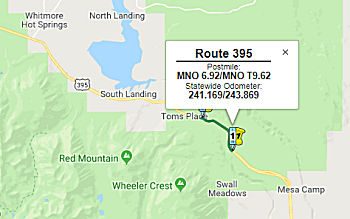 In October 2018, the CTC approved for for future consideration of funding the
following project for which a Mitigated Negative Declaration (MND) has
been completed: US 395 in Mono County (09-Mno-395, PM 6.92/9.62). Widen
existing shoulders on a portion of US 395 in Mono County. (PPNO 0662) This
project is located on US 395 between Bishop and Toms Place in Mono County.
The project proposes to widen the existing paved highway shoulders at the
project location. The proposed project addresses the need to reduce the
number and severity of collisions and enhance safety. Also included in the
proposed project will be added rumble strips, replacement of guardrails,
upgrading of drainage systems, modification to slopes for improvement in
sight distances around curves and additions to bicycle right turn lanes.
The proposed project is currently estimated to cost approximately $22.5
million. This project is fully funded and is currently programmed in the
2018 SHOPP for approximately $20.4 million which includes Construction
(capital and support) and Right-of-Way (capital and support). Construction
is estimated to begin in Fiscal Year 2020-21. The scope, as described for
the preferred alternative, is consistent with the project scope programmed
by the Commission in the 2018 SHOPP.
In October 2018, the CTC approved for for future consideration of funding the
following project for which a Mitigated Negative Declaration (MND) has
been completed: US 395 in Mono County (09-Mno-395, PM 6.92/9.62). Widen
existing shoulders on a portion of US 395 in Mono County. (PPNO 0662) This
project is located on US 395 between Bishop and Toms Place in Mono County.
The project proposes to widen the existing paved highway shoulders at the
project location. The proposed project addresses the need to reduce the
number and severity of collisions and enhance safety. Also included in the
proposed project will be added rumble strips, replacement of guardrails,
upgrading of drainage systems, modification to slopes for improvement in
sight distances around curves and additions to bicycle right turn lanes.
The proposed project is currently estimated to cost approximately $22.5
million. This project is fully funded and is currently programmed in the
2018 SHOPP for approximately $20.4 million which includes Construction
(capital and support) and Right-of-Way (capital and support). Construction
is estimated to begin in Fiscal Year 2020-21. The scope, as described for
the preferred alternative, is consistent with the project scope programmed
by the Commission in the 2018 SHOPP.
(Source: October 2018 CTC Agenda Item 2.2c.(1))
The 2020 SHOPP, approved in May 2020, included the
following Collision Reduction item of interest (carried over from the 2018
SHOPP): 09-Mono-395 PM 6.9/9.6 PPNO 0662 Proj ID 0914000003 EA 36070. US 395 near Tom's Place, from 2.4 miles south of Lower Rock Creek Road to
0.3 mile north of Lower Rock Creek Road. Widen shoulders, flatten
slopes, install ground in rumble strips, reconstruct and install
guardrail. Programmed in FY20-21, with construction scheduled to start in
November 2020. Total project cost is $22,451K, with $16,208K being capital
(const and right of way) and $6,243K being support (engineering,
environmental, etc.).
(Source: 2020 Approved SHOPP a/o May 2020)
In October 2020, the CTC approved the following SHOPP
Construction Phase allocation: $17,610,000 for Mono 09-Mno-395 PM
R6.9/T9.6. PPNO 09-0662 ProjID 0914000003 EA 36070. US 395 Near Tom's
Place, from 2.4 miles south of Lower Rock Creek Road to 0.3 mile north of
Lower Rock Creek Road. Outcome/Output: Reduce the number and
severity of collisions by widening shoulders, flattening slopes,
installing rumble strips, and reconstructing and installing guardrail. Con
Eng $2,799,000; Const $15,840,000. (CEQA - MND, 7/24/2018; Re-validation
7/27/2020) (NEPA - FONSI, 7/24/2018; Re-validation 7/27/2020) (Future
consideration of funding approved under Resolution E-18-130; October
2018.)
(Source: October 2020 CTC Agenda, Agenda Item
2.5b.(1) #21)
In May 2019, the CTC approved for future consideration of funding a
project located on US 395 between the towns of Mammoth and June Lake
(09-Mno-395, PM 30.7 & 36.5), in Mono County. The project proposes to
pave three locations to provide off-highway parking to access hiking,
bicycle and snowmobile trails along US 395. The project addresses the need
to provide winter access parking for recreations users and to avoid
parking on highway shoulders creating potential hazard for snow plowing
and motorists. The proposed project has been developed and studied in
conjunction with the US Forest Service-Inyo National Forest. The estimated
total overall cost of the project is $1.6 million. The project is not
currently programmed in the SHOPP. The project is estimated to begin in
Fiscal Year 2020-21.
(Source: May 2019 CTC Minutes, Agenda Item
2.2c.(1))
In August 2015, the CTC authorized vacation of right of way in the county of Mono along Route 395 at Material Site Number 190, approximately 0.8 mile north of Route 120 (approx MNO 51.595), consisting of highway right of way (a material site) no longer needed for State highway purposes. The site will revert to the Bureau of Land Management.
Conway Ranch Shoulder Widening Project (09-Mono-395 PM 58.2/60.4)
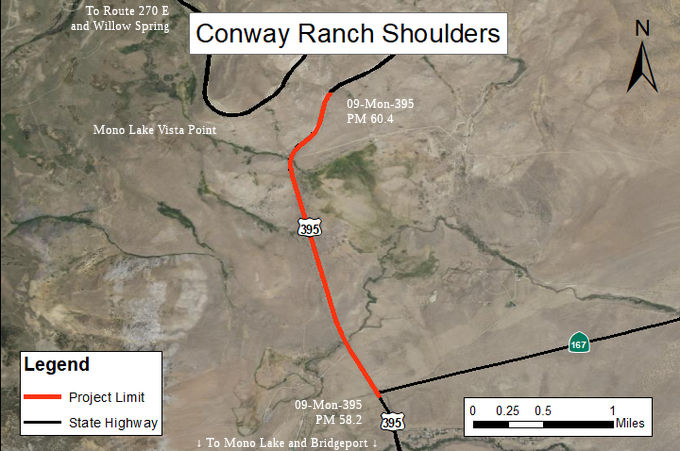 The 2020 SHOPP, approved in May 2020, included the following Collision Reduction
item of interest (carried over from the 2018 SHOPP): 09-Mono-395 PM
58.2/60.2 PPNO 2624 Proj ID 0916000006 EA 36640. US 395 near Lee Vining,
from Route 167 Junction to 0.2 mile north of Conway Ranch Road. Widen
shoulders, install shoulder rumble strip, correct compound curve, and
improve chain control area. Programmed in FY21-22, with construction
scheduled to start in January 2023. Total project cost is $9,376K, with
$5,996K being capital (const and right of way) and $3,380K being support
(engineering, environmental, etc.).
The 2020 SHOPP, approved in May 2020, included the following Collision Reduction
item of interest (carried over from the 2018 SHOPP): 09-Mono-395 PM
58.2/60.2 PPNO 2624 Proj ID 0916000006 EA 36640. US 395 near Lee Vining,
from Route 167 Junction to 0.2 mile north of Conway Ranch Road. Widen
shoulders, install shoulder rumble strip, correct compound curve, and
improve chain control area. Programmed in FY21-22, with construction
scheduled to start in January 2023. Total project cost is $9,376K, with
$5,996K being capital (const and right of way) and $3,380K being support
(engineering, environmental, etc.).
(Source: 2020 Approved SHOPP a/o May 2020)
In August 2020, the CTC approved the following
financial allocation: $830,000 for PS&E; $590,000 for R/W Support.
09-Mno-395 PM 58.2/60.2. PPNO 2624 ProjID 0916000006 EA 36640. US 395 Near
Lee Vining, from Route 167 Junction to 0.2 mile north of Conway Ranch
Road. Widen shoulders, install shoulder rumble strip, correct compound
curve, and improve chain control area.
(Source: August 2020 CTC Agenda, Agenda Item
2.5b.(2a) #28)
In May 2021, the CTC amended this project in the
SHOPP: (1d) #51. 09-Mno-395 58.2/60.2 58.2/60.4
PPNO 2624 ProjID 0916000006 EA 36640. US 395 Near Lee Vining, from Route 167 Junction to 0.2 0.4 mile north of Conway Ranch
Road. Widen shoulders, install shoulder rumble strip, correct
compound curve, and improve chain control area. Amended to update
description and postmiles to extend the project limits to correct an
existing compound curve by removing and replacing striping.
(Source: May 2021 CTC Agenda, Agenda Item 2.1a.(1d)
#51)
In November 2021, it was reported that Caltrans
District 9 was seeking public comment on the proposed Conway Ranch
Shoulders Project. The Conway Ranch Shoulder Widening project proposes to
widen the existing paved shoulders on US 395 from the junction with Route 167 to 0.4 miles north of Conway Ranch Road in Mono County. It also
proposes to install shoulder rumble strips, correct a substandard compound
curve and lengthen the chain control area at postmile 59.2 by 500 feet.
Culverts will be extended or replaced as needed. There one build and one
no-build alternative under consideration for the project. The proposed
features of the Build Alternative are the following: (•) Existing
alignment, shoulder widening to both sides; (•) Eight-foot wide
outside shoulders; shoulder ground-in skip rumble strips; (•)
Lengthen the existing northbound chain installation/removal area at
postmile 59.20 to postmile 59.28 to the south 500 feet; (•) Install
switch controlled lighting at chain installation/removal area; (•)
Curve correction restripe; (•) Where required, fill slopes to 4:1 or
flatter fill to the clear recover zone; (•) From edge of the clear
recovery zone, variable fill slope to edge of Right of Way; (•)
Correct clear recovery zone slope and hit object conditions; (•)
Guard rail at select locations; (•) Extend culverts; and (•)
Erosion control, reclaim and revegetate.
(Source: Caltrans District 9 on Twitter, 11/5/2021; Caltrans Project Page)
In March 2023, the CTC approved an additional
$2,508,000 in Construction Capital for the SHOPP Collision Severity
Reduction project on US 395, in Mono County, to award the construction
contract. This project is located on US 395 near Lee Vining, from
the Route 167 junction to north of Conway Ranch Road, in Mono
County. The project will widen shoulders, install shoulder rumble
strip, perform curve correction work, and improve chain control areas. In
October 2022, the Department advertised the contract and held bid opening
in November 2022. The contract received four bids, of which the lowest bid
is 21.4 percent above the Engineer’s Estimate (EE), however the
bidder was found to be non-responsive. The second lowest bid is 45.3
percent over the EE, and the two remaining bids are 62.6 and 119.6 percent
over the EE. As evident by the latest market trends, current prices have
risen significantly due to fluctuations in the economy, supply chain
shortages, and oil costs. As a result, there are increases, above
the EE, for pipe culvert structural concrete, traffic control, electrical,
and hot mix asphalt items. In addition, due to the remoteness of the
project’s location, the sub-contractor’s prices came in even
higher than anticipated. The remoteness also affected the
costs associated with traffic control and electrical items as contractors
have seen a decrease in the number of participating subcontractors. The
contractors have also cited higher trucking costs to deliver the imported
material and temporary barrier system to the job site. The temporary
creek diversion systems item also has a cost increase due to the
difference in the contractor’s means and methods and the unknown
risk that was accounted for, to prepare the site, prior to installing the
diversion system.
(Source: March 2023 CTC Agenda, Agenda Item 2.5e.(11))
In May 2019, the CTC deleted the long-lead project 09-Mno-395 69.9/71.9.
PPNO 2639. Proj ID 0917000014. On US 395 Near Bridgeport, from north
of Route 270 Junction to Green Creek Road. Widen shoulders to eight
feet, install rumble strips, improve sight distance, and upgrade signing
and striping to current standards . Remove project from the Long
Lead list and develop a Minor project to install rumble strips.
(Source: May 2019 CTC Agenda Item 2.1a.(1) Item
LL#2)
In May 2015, the CTC approved for future consideration of funding a project in Mono County that will widen the paved shoulders on a portion of US 395 near the town of Bridgeport (approx MNO 75.846). The project is programmed in the 2014 State Highway Operation and Protection Program. The estimated cost is $16,574,000 for capital and support. Construction is estimated to begin in Fiscal Year 2016-17. The scope, as described for the preferred alternative, is consistent with the project scope programmed by the Commission in the 2014 State Highway Operation and Protection Program.
Aspen Fales Shoulder Widening Project (09-Mno-395 PM 88.42/91.55)
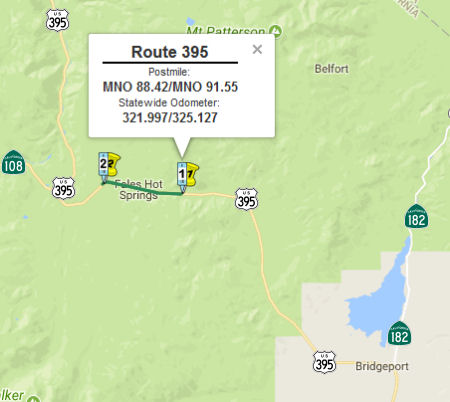 In August 2017, the CTC approved for future consideration
of funding 09-Mno-395 PM 88.42/91.55 Aspen Fales Shoulder Widening
Project: This project in Mono County will widen shoulders on US 395 in the
town of Bridgeport. The project will improve safety and operations for the
traveling public. The project will be funded from State Highway Operation
and Protection Program (SHOPP) funds and is programmed in the 2016 SHOPP
for an estimated $14.2 million Construction (capital and support) and
Right of Way (capital and support). Construction is estimated to begin in
Fiscal Year 2018-19. The scope, as described for the preferred
alternative, is consistent with the project scope programmed by the
Commission in the 2016 SHOPP. A copy of the FEIR has been provided to
Commission staff. Resources that may be impacted by the project include
visual and aesthetics, cultural resources, noise, and biological
resources. Potential impacts associated with the project can all be
mitigated to below significance. As a result, an FEIR was prepared for the
project.
In August 2017, the CTC approved for future consideration
of funding 09-Mno-395 PM 88.42/91.55 Aspen Fales Shoulder Widening
Project: This project in Mono County will widen shoulders on US 395 in the
town of Bridgeport. The project will improve safety and operations for the
traveling public. The project will be funded from State Highway Operation
and Protection Program (SHOPP) funds and is programmed in the 2016 SHOPP
for an estimated $14.2 million Construction (capital and support) and
Right of Way (capital and support). Construction is estimated to begin in
Fiscal Year 2018-19. The scope, as described for the preferred
alternative, is consistent with the project scope programmed by the
Commission in the 2016 SHOPP. A copy of the FEIR has been provided to
Commission staff. Resources that may be impacted by the project include
visual and aesthetics, cultural resources, noise, and biological
resources. Potential impacts associated with the project can all be
mitigated to below significance. As a result, an FEIR was prepared for the
project.
In January 2019, the CTC approved the following
allocation: $9,555,000 Mono 09-Mno-395 88.4/91.6. US 395 Near Bridgeport,
from north of Devils Gate Summit to Burcham Flat Road. Outcome/Output:
Widen shoulders and construct rumble strip. This project will reduce the
number and severity of collisions. Future consideration of funding
approved under Resolution E-17-54; August 2017. Related supplemental funds
vote to re-advertise EA 35780/PPNO 09-0615 under Ref. 2.5e.(2), Resolution
FA-18-36.
(Source: January 2019 CTC Minutes, Agenda Item
2.5b.(1) Item 21)
In July 2019, Caltrans began holding preliminary
meetings on the Aspen-Walker Shoulder Widening Project, which will widen
the highway shoulders from the existing width of 2-3 feet to 8 feet, as
well as construct retaining walls and install rumble strips. The project
will run along US 395 from 5 miles south of Sonora Junction at State Route 108 to 2 miles north of the junction (~ MNO 88.765/MNO 95.765).
(Source: Record Courier, 7/13/2019)
Sonora Junction Shoulders Project (09-Mno-395, PM 91.6/93.4)
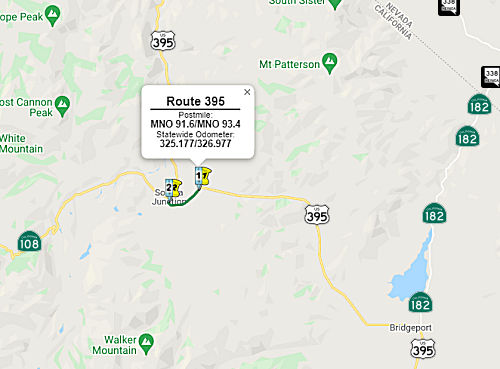 In January 2019, the CTC approved a request for an
additional $2,985,000 for the State Highway Operation Protection Program
(SHOPP) Collision Severity Reduction project (PPNO 0615) on US 395, in
Mono County, to re-advertise the construction contract. This project is
located on US 395, near the town of Bridgeport, in Mono County (09-Mno-395
93.4/95.7). The project will widen shoulders, install rumble strips,
replace and upgrade guardrails, install new concrete barriers, improve
roadway cross-slope and stopping sight distance, and install rock-fall
protection to reduce the severity and number of collisions. The
performance measure goal is to reduce collisions by 28 collisions and
improve 2.9 lane miles from “fair” to “good”
condition and improve one census station from “poor” to
“good” condition. The improvement is consistent with the
Commission-adopted goals and objectives of the Transportation Asset
Management Plan. As of January 2019, all contract bids have been rejected.
The Department will re-advertise the contract upon approval of this
supplemental funds request. The updated certified Engineers Estimate and
adjusted project cost is expected to attract more bidders when the project
is re-advertised in February 2019 if this supplemental fund request is
approved. Over the last half year, the Department has seen a trend that
shows a significant increase in the cost of materials and significant
decrease of available contractors and subcontractors in a busy
construction market. Based on the discussion with several non-bidding
contractors, the Department believes that readvertising the project is in
the best interest of the State, as the Department is combining this
project with the Aspen Fales Shoulder Widening Project, for construction.
This will help decrease the overall costs and allow the contractor to
control the entire operations of both projects, therefore eliminate
dueling prime contractors and subcontractors working adjacent to each
other. The Department will also perform contractors outreach events during
the advertisement period. The Department will also make available a site
near the city of Lee Vining for contractors use as the Baseline Material
Site. In addition, both projects to the north and south, have since been
completed so the project is no longer “land-locked” between
ongoing construction or competing contractors. Based on conversations with
those non-bidding contractors, this could also provide a more favorable
bidding environment upon re-advertising the project.
In January 2019, the CTC approved a request for an
additional $2,985,000 for the State Highway Operation Protection Program
(SHOPP) Collision Severity Reduction project (PPNO 0615) on US 395, in
Mono County, to re-advertise the construction contract. This project is
located on US 395, near the town of Bridgeport, in Mono County (09-Mno-395
93.4/95.7). The project will widen shoulders, install rumble strips,
replace and upgrade guardrails, install new concrete barriers, improve
roadway cross-slope and stopping sight distance, and install rock-fall
protection to reduce the severity and number of collisions. The
performance measure goal is to reduce collisions by 28 collisions and
improve 2.9 lane miles from “fair” to “good”
condition and improve one census station from “poor” to
“good” condition. The improvement is consistent with the
Commission-adopted goals and objectives of the Transportation Asset
Management Plan. As of January 2019, all contract bids have been rejected.
The Department will re-advertise the contract upon approval of this
supplemental funds request. The updated certified Engineers Estimate and
adjusted project cost is expected to attract more bidders when the project
is re-advertised in February 2019 if this supplemental fund request is
approved. Over the last half year, the Department has seen a trend that
shows a significant increase in the cost of materials and significant
decrease of available contractors and subcontractors in a busy
construction market. Based on the discussion with several non-bidding
contractors, the Department believes that readvertising the project is in
the best interest of the State, as the Department is combining this
project with the Aspen Fales Shoulder Widening Project, for construction.
This will help decrease the overall costs and allow the contractor to
control the entire operations of both projects, therefore eliminate
dueling prime contractors and subcontractors working adjacent to each
other. The Department will also perform contractors outreach events during
the advertisement period. The Department will also make available a site
near the city of Lee Vining for contractors use as the Baseline Material
Site. In addition, both projects to the north and south, have since been
completed so the project is no longer “land-locked” between
ongoing construction or competing contractors. Based on conversations with
those non-bidding contractors, this could also provide a more favorable
bidding environment upon re-advertising the project.
(Source: January 2019 CTC Minutes, Agenda Item 2.5e(2))
The 2020 SHOPP, approved in May 2020, included the
following Collision Reduction item of interest (carried over from the 2018
SHOPP): 09-Mono-395 PM 91.6/93.4 PPNO 2460 Proj ID 0917000011 EA 36800. US 395 near Bridgeport, from Burcham Flat Road to 0.3 mile south of Route 395/Route 108 Junction. Widen shoulders, install rumble strips, and
correct superelevation at three curves. Programmed in FY22-23, with
construction scheduled to start in December 2023. Total project cost is
$20,060K, with $14,422K being capital (const and right of way) and $5,638K
being support (engineering, environmental, etc.).
(Source: 2020 Approved SHOPP a/o May 2020)
In August 2021, the CTC approved the following project
for future consideration of funding: 09-Mno-395, PM 91.6/93.4. Sonora
Junction Shoulders Project. Widen paved highway shoulders, correct
the super- elevation of three curves, add rumble strips, replace
guardrails, and rehabilitate pavement on US 395 in Mono County. (MND)
(PPNO 2460) (SHOPP). This project is located on US 395 from post mile 91.6
to 93.4, in Mono County. The Department proposes to construct 8-foot
shoulders on both the northbound and southbound sides of the highway
throughout the project limits. In addition, deer exclusion fencing and two
wildlife undercrossing structures will be constructed. This project is
currently programmed in the 2020 SHOPP for a total of $20,060,000, which
includes Construction (capital and support) and Right of Way (support).
Construction is estimated to begin in 2023-24. The scope, as described for
the preferred alternative, is consistent with the project scope as
programmed by the Commission in the 2020 SHOPP. A copy of the MND has been
provided to Commission staff. The project will result in less than
significant impacts to the environment after mitigation. The
following resource areas may be impacted by the project: biological
resources. Avoidance and minimization measures will reduce any
potential effects on the environment. These measures include, but are not
limited to, purchasing credits from a mitigation bank or by paying into an
in-lieu fee program to mitigate permanent impacts to waters and riparian
vegetation. As a result, an MND was completed for this project.
(Source: August 2021 CTC Agenda, Agenda Item
2.2c.(1))
Also in August 2021, the CTC approved the following
preconstruction allocation: 09-Mno-395 91.6/93.4. PPNO 09-2460; ProjID
0917000011; EA 36800. US 395 Near Bridgeport, from Burcham Flat Road to
0.3 mile south of Route 395/108 Junction. Widen shoulders, install rumble
strips, and correct superelevation at three curves. (Concurrent
consideration of funding under Resolution E-21-87; August 2021.)
Allocation: PS&E $1,764,000; R/W Sup $395,000.
(Source: August 2021 CTC Agenda, Agenda Item
2.5b.(2a) #16)
In June 2022, the CTC amended this project in the SHOPP
as follows: 09-Mno-395 91.6/93.4. PPNO 09-2460; ProjID 0917000011; EA
36800. US 395 Near Bridgeport, from Burcham Flat Road to 0.3 mile south of
Route 108 395/108 Junction. Widen shoulders,
install rumble strips, install wildlife crossing and fencing
and correct superelevation at three curves. Note: Add wildlife crossing
and fencing scope to project and description, which increases construction
capital. Decrease R/W capital due to reduced environmental impacts,
resulting in lower mitigation costs. Also, increases in unit cost of
asphalt and in quantities of import borrow material and a required
temporary realignment results in additional construction capital cost
increases. Amendments ($ × 1,000): R/W Cap $1,855 ⇒ $1,366;
Const Cap $12,567 ⇒ $16,854; TOTAL $20,060 ⇒ $23,858.
(Source: June 2022 CTC Agenda, Agenda Item
2.1a.(1d) #78)
In October 2023, the CTC approved for consideration of
funding the following project for which a MND and an Addendum have been
completed: US 395 in Mono County. Construct 8-foot shoulders on both sides
of US 395, and construct deer exclusion fencing and two wildlife
undercrossing structures, in Mono County. (09-Mno-395, PM 91.6/93.4; PPNO
2460). The project is currently programmed in the 2022 SHOPP for a total
of $23,858,000, which includes Right of Way (Support and Capital) and
Construction (Support and Capital). Construction began in 2023-24. The
scope, as described for the preferred alternative, is consistent with the
project scope as programmed by the Commission in the 2022 SHOPP. A copy of
the MND has been provided to Commission staff. The Commission approved the
project for future consideration of funding on August 18, 2021, under
Resolution E-21-87. Since the approval of the MND, there have been changes
to the project and an Addendum was prepared pursuant to CEQA. These
changes include the need to drill up to 8 borings as part of a subsurface
exploration program to characterize the existing subsurface conditions to
provide geotechnical information for the design of retaining walls, animal
under crossings, shoulder widening, and cut/fill slopes. The work involved
did not have the potential to result in a new significant environmental
effect or a substantial increase in the severity of a previously
identified significant effect disclosed in the MND. No substantial changes
have occurred with respect to the project circumstances or effects,
severity of effects, alternatives, or mitigation measures. The project
changes do not meet the criteria outlined in CEQA Guidelines Section 15162
to prepare a Subsequent MND. The Department subsequently completed an
Addendum to the MND pursuant to CEQA. The Department has approved this
project for construction. This approval and the Addendum will satisfy the
environmental requirements for this stage of the planning process.
(Source: October 2023 CTC Agenda, Agenda Item 2.2c.(4))
In October 2023, the CTC approved the following
allocation for a SHOPP Project: $18,754,000. 09-Mno-395 91.6/93.4. PPNO
09-2460; ProjID 0917000011; EA 36800. US 395 Near Bridgeport, from Burcham
Flat Road to 0.3 mile south of Route 108. Outcome/Output: Reduce the
number and severity of collisions by widening shoulders, installing rumble
strips, wildlife crossing and fencing, and correcting roadway cross slope
at three curves. CEQA - MND, 5/28/2021; Re-validation 6/22/2023. NEPA -
FONSI, 5/28/2021; Re-validation 6/22/2023. Future consideration of funding
approved under Resolution E-21-87; August 2021. Seven month allocation
time extension for CONST and CON ENG approved under Waiver 23-72; June
2023. Concurrent Amendment under SHOPP Amendment 22H-012; October 2023.
Concurrent addendum for the previously approved Future Consideration of
Funding under Resolution E-23-136A; October 2023. Allocation: CON ENG
$2,084,000; CONST $16,854,000.
(Source: October 2023 CTC Agenda, Agenda Item 2.5b.(1) #13)
In June 2023, the CTC amended the following project into the 2022 SHOPP:
09-Mno-395 118.4/118.8. PPNO 09-2709; ProjID 0923000047; EA 39930. US 395
Near Topaz, from 2.1 miles to 1.7 miles south of the Nevada State
line. Shift the alignment to the west and cut back the failing
slope and install a rock drapery netting. Note: A slip-out of the
embankment under the northbound lane was discovered on March 19, 2023,
creating a crevice 6 to 12 inches wide and 300 feet long in the shoulder
and traveled way. Additional cracks were found in the unpaved
shoulder. The lane was immediately closed and traffic was limited to
reversible one-way traffic control. This project will set up an automatic
traffic control signal system, cut back the slope, install rock drapery
netting on the cut slope, and shift the roadway alignment to the west,
away from the slip plane and onto a stable foundation. Allocation ($
× 1,000): PA&ED $0; PS&E $0; R/W Sup $100; Con Sup $750; R/W
Cap $100; Const Cap $7,500; TOTAL $8,450. FY22-23.
(Source: June 2023 CTC Agenda, Agenda Item 2.1a.(1a) #51)
 Naming
Naming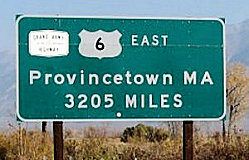 The portion of this route that was cosigned with US 6 (i.e., from Route 14 to US 6 in Bishop
(~ KER 26.958 to INY 114.898) was named the "Grand Army of the Republic
Highway" by Assembly Concurrent Resolution 33, Chapter 73, in 1943.
According to CalTrans in March 1994, the Grand Army route is now US 6,
then US 395 to Route 14, Route 14 to I-5, I-5 to I-110, and then south to
San Pedro. A monument marking the western terminus of the Grand Army
Highway may be found on the wall on the S side of Ocean Avenue, in front
of the Terrace Theatre.
The portion of this route that was cosigned with US 6 (i.e., from Route 14 to US 6 in Bishop
(~ KER 26.958 to INY 114.898) was named the "Grand Army of the Republic
Highway" by Assembly Concurrent Resolution 33, Chapter 73, in 1943.
According to CalTrans in March 1994, the Grand Army route is now US 6,
then US 395 to Route 14, Route 14 to I-5, I-5 to I-110, and then south to
San Pedro. A monument marking the western terminus of the Grand Army
Highway may be found on the wall on the S side of Ocean Avenue, in front
of the Terrace Theatre.
(Image Source: Clamshack on Flikr)
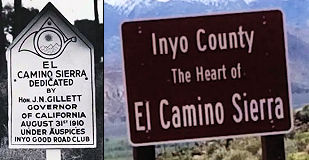 Historically, the portion of this route from Route 14 to
Bridgeport (~ KER 26.958 to MNO 76.758) was part of "El Camino Sierra"
(Road to the Mountains). El Camino Sierra is the name given to US 395 and
the southern portion of US 6 by the Bishop based, Inyo Good Road Club back
in 1910. The name was part of a marketing plan to draw the attention of
Sacramento politicians and highway department officials to this lightly
populated area of the state, in order to obtain a share of the first state
highway construction bond, to build new roads in Inyo and Mono counties.
Historically, the portion of this route from Route 14 to
Bridgeport (~ KER 26.958 to MNO 76.758) was part of "El Camino Sierra"
(Road to the Mountains). El Camino Sierra is the name given to US 395 and
the southern portion of US 6 by the Bishop based, Inyo Good Road Club back
in 1910. The name was part of a marketing plan to draw the attention of
Sacramento politicians and highway department officials to this lightly
populated area of the state, in order to obtain a share of the first state
highway construction bond, to build new roads in Inyo and Mono counties.
(Image source: Sierra Wave; YouTube)
In March 2017, it was reported that the Inyo County
Board of Supervisor’s heard a presentation on the county’s
plan for a reintroduction and dedication, of US 395 to its original name
of El Camino Sierra. During the presentation, County Chief Administrative
Officer Kevin Carunchio briefed the Board on the County’s recent
efforts to resurrect and promote the name El Camino Sierra, telling the
Board that banners had been placed at the north and south entrances of
Lone Pine, Independence, Big Pine and Bishop, promoting the towns as being
in “the Heart of El Camino Sierra.” Carunchio also stated that
Inyo County was in the process of placing new highway signs at the
county’s north and south borders, that also proclaimed “Inyo
County-The Heart of El Camino Sierra.” Carunchio indicated the
banners and signs, along with a few other measures, were part of a phase
one in the County’s efforts, and sought the Board’s approval
to move forward with a phase two. The highlight of this next part of the
El Camino Sierra promotional efforts would be to have interpretive highway
markers erected and placed at various historic sites throughout Inyo
County. Carunchio explained that the signs would be built in the shape of
the historic markers first erected by the Inyo Good Roads Club back in
1910. Carunchio displayed a prototype of the new markers to the Board and
the audience that was present.
(Source: Sierra Wave)
 The segment of US 395 from Gill Station Coso Road to the
junction with Route 190 in the County of Inyo (~ INY R17.857 to INY
34.479) is named the "Paul H. Pino Memorial Highway". This segment
was named in memory of California Highway Patrol Officer Paul H. Pino,
badge number 9735, who was killed in the line of duty during the morning
of December 30, 2003. Paul H. Pino was issuing a citation on US 395 south
of Olancha in the County of Inyo when an impaired driver collided into his
patrol vehicle killing the officer; he succumbed to his injuries as a
result of the collision. Officer Pino was born on August 26, 1955, in The
Hague, Holland. He immigrated to the United States in 1960 and
subsequently relocated to Carson, California. He attended and graduated
from Carson High School in 1973; from Los Angeles Harbor College with a
degree in Police Science in 1977; and joined the Los Angeles County
Sheriff's Department as a Deputy Sheriff in 1977 and served in that
capacity for three years. He joined the California Highway Patrol in
August, 1980. After successfully completing his academy training, he
reported to the South Los Angeles Area as an officer on January 8, 1981.
Paul H. Pino made significant contributions to traffic safety and
assisting the motoring public while assigned to the South Los Angeles,
Barstow, and Bishop Area offices; in total, he served 23 years as a sworn
peace officer for the California Highway Patrol and was known by his
fellow officers for his dedication to the department and to the protection
of the citizens of our state. Named by Senate Concurrent Resolution (SCR)
55, Resolution Chapter 50, on 5/9/2006.
The segment of US 395 from Gill Station Coso Road to the
junction with Route 190 in the County of Inyo (~ INY R17.857 to INY
34.479) is named the "Paul H. Pino Memorial Highway". This segment
was named in memory of California Highway Patrol Officer Paul H. Pino,
badge number 9735, who was killed in the line of duty during the morning
of December 30, 2003. Paul H. Pino was issuing a citation on US 395 south
of Olancha in the County of Inyo when an impaired driver collided into his
patrol vehicle killing the officer; he succumbed to his injuries as a
result of the collision. Officer Pino was born on August 26, 1955, in The
Hague, Holland. He immigrated to the United States in 1960 and
subsequently relocated to Carson, California. He attended and graduated
from Carson High School in 1973; from Los Angeles Harbor College with a
degree in Police Science in 1977; and joined the Los Angeles County
Sheriff's Department as a Deputy Sheriff in 1977 and served in that
capacity for three years. He joined the California Highway Patrol in
August, 1980. After successfully completing his academy training, he
reported to the South Los Angeles Area as an officer on January 8, 1981.
Paul H. Pino made significant contributions to traffic safety and
assisting the motoring public while assigned to the South Los Angeles,
Barstow, and Bishop Area offices; in total, he served 23 years as a sworn
peace officer for the California Highway Patrol and was known by his
fellow officers for his dedication to the department and to the protection
of the citizens of our state. Named by Senate Concurrent Resolution (SCR)
55, Resolution Chapter 50, on 5/9/2006.
(Image source: Calif. Assn of Highway Patrolmen)
 The segment of US 395 from its intersection with Warm Springs Road in Inyo County to the
southern city limits of Bishop (~ INY 112.873 to INY 114.853) is named the
"Police Officer Richard Perkins Memorial Highway". Named in honor
of Officer Richard E. Perkins of the Bishop Police Department, who was
killed in the line of duty on August 15, 2001, when a truck struck his
patrol car as he was making a turn in order to assist another law
enforcement agency in pursuit of a possible drunk driver. Officer Perkins
was an 11-year veteran of the Bishop Police Department, was highly
respected in the community he served, and is survived by his wife Cheryl
and three children, Andrew, Pauli, and Kati. He was the first police
officer to die in the line of duty in the City of Bishop's 100-year
history. He was dedicated to family, friends, church, and the community,
and was known for his work with the Bishop Mural Society and as one of the
founding members of the Bishop Police Mounted Unit. Named by Senate
Concurrent Resolution 46, Chapter 53, May 5, 2004.
The segment of US 395 from its intersection with Warm Springs Road in Inyo County to the
southern city limits of Bishop (~ INY 112.873 to INY 114.853) is named the
"Police Officer Richard Perkins Memorial Highway". Named in honor
of Officer Richard E. Perkins of the Bishop Police Department, who was
killed in the line of duty on August 15, 2001, when a truck struck his
patrol car as he was making a turn in order to assist another law
enforcement agency in pursuit of a possible drunk driver. Officer Perkins
was an 11-year veteran of the Bishop Police Department, was highly
respected in the community he served, and is survived by his wife Cheryl
and three children, Andrew, Pauli, and Kati. He was the first police
officer to die in the line of duty in the City of Bishop's 100-year
history. He was dedicated to family, friends, church, and the community,
and was known for his work with the Bishop Mural Society and as one of the
founding members of the Bishop Police Mounted Unit. Named by Senate
Concurrent Resolution 46, Chapter 53, May 5, 2004.
(Image source: Officer Down Memorial Page)
Just off of US 395 is the community of Bodie (exit at Rout 270, MNO 0.064) Bodie has been designated the Official State Gold Rush Ghost Town. Bodie was founded by Waterman S. Body in 1859, and rose to prominence due to mining in the nearby Comstock Lode. At its peak in 1879, Bodie boasted a population of 10,000 citizens and had a reputation for its wicked climate as well as its clientele. By 1882, the big strikes were mostly gone and with them the need to stay in Bodie. One hundred twenty years later, in 2002, Bodie is one of the largest and best-preserved ghost towns in the West. Designed by Assembly Bill 1757, Chapter 365, 9/5/2002.
 The portion of US 395 from the South Buckeye Creek Bridge (Bridge 47–33; MNO
79.168) to the junction of Route 182 (MNO 76.3) in the County of Mono is
named the "Senator David E. Cogdill, Sr., Memorial Highway".
It was named in memory of Senator David E. “Dave” Cogdill,
Sr., born in December 1950, in Long Beach, and was raised in San
Bernardino until moving with his family, in his senior year of high
school, to Bridgeport. After high school, Senator Cogdill enlisted in the
United States Air Force and served as a member of the Air National Guard.
Senator Cogdill began his professional career in Bridgeport in 1971, as a
clerk-typist in the Mono County Assessor’s Office, eventually
becoming Chief Appraiser, then, at the end of the decade, moved to
Modesto, where, in 1981, he and David R. Giomi cofounded the appraisal
firm Cogdill & Giomi, which became one of the oldest, best known, and
most respected appraisal firms in the Central Valley. In Bridgeport and
Modesto, Senator Cogdill demonstrated a tireless commitment to his church
and community, taking on leadership roles in organizations ranging from
the Bridgeport Fire Protection District, the Bridgeport Volunteer Fire
Department, and the YMCA of Stanislaus County to the Modesto Chamber of
Commerce and the Modesto City Council. In 2000, Senator Cogdill was
elected to the California State Assembly to represent the 25th Assembly
District, which included Calaveras, Mariposa, Mono, and Tuolumne Counties,
and portions of Madera and Stanislaus Counties, and, during his six-year
tenure, became Assembly Minority Floor Leader. During this time, Senator
Cogdill, with Senator Charles S. “Chuck” Poochigian, revived
the California State Legislature Rural Caucus to amplify the concerns of
rural communities, including by collaborating with local leadership to
advocate for access to health care and quality education in those
communities. In 2006, Senator Cogdill was elected to the California State
Senate to represent the 14th Senate District, which included Mariposa and
Tuolumne Counties and portions of Fresno, Madera, San Joaquin, and
Stanislaus Counties, and, in 2008 and 2009, was Senate Republican Leader.
As Senator, Senator Cogdill was recognized as Senate Small Business
Legislator of the Year by the California Small Business Association, and
honored by the John F. Kennedy Library Foundation with the prestigious
Profile in Courage Award for taking on a challenging leadership role
during the first year of the state budget crisis of 2008–12. Senator
Cogdill remained active in community and statewide organizations after
leaving the Legislature, becoming Stanislaus County Assessor in 2011, and
President and Chief Executive Officer of the California Building Industry
Association in 2013. Through his untimely death on July 23, 2017, at 66
years of age, Senator Cogdill was a man of faith, stoic and steadfast, who
strove to do more than his duty to make the lives around him better. Named
by Senate Concurrent Resolution (SCR) 133, Res. Chapter 243, 9/12/2018.
The portion of US 395 from the South Buckeye Creek Bridge (Bridge 47–33; MNO
79.168) to the junction of Route 182 (MNO 76.3) in the County of Mono is
named the "Senator David E. Cogdill, Sr., Memorial Highway".
It was named in memory of Senator David E. “Dave” Cogdill,
Sr., born in December 1950, in Long Beach, and was raised in San
Bernardino until moving with his family, in his senior year of high
school, to Bridgeport. After high school, Senator Cogdill enlisted in the
United States Air Force and served as a member of the Air National Guard.
Senator Cogdill began his professional career in Bridgeport in 1971, as a
clerk-typist in the Mono County Assessor’s Office, eventually
becoming Chief Appraiser, then, at the end of the decade, moved to
Modesto, where, in 1981, he and David R. Giomi cofounded the appraisal
firm Cogdill & Giomi, which became one of the oldest, best known, and
most respected appraisal firms in the Central Valley. In Bridgeport and
Modesto, Senator Cogdill demonstrated a tireless commitment to his church
and community, taking on leadership roles in organizations ranging from
the Bridgeport Fire Protection District, the Bridgeport Volunteer Fire
Department, and the YMCA of Stanislaus County to the Modesto Chamber of
Commerce and the Modesto City Council. In 2000, Senator Cogdill was
elected to the California State Assembly to represent the 25th Assembly
District, which included Calaveras, Mariposa, Mono, and Tuolumne Counties,
and portions of Madera and Stanislaus Counties, and, during his six-year
tenure, became Assembly Minority Floor Leader. During this time, Senator
Cogdill, with Senator Charles S. “Chuck” Poochigian, revived
the California State Legislature Rural Caucus to amplify the concerns of
rural communities, including by collaborating with local leadership to
advocate for access to health care and quality education in those
communities. In 2006, Senator Cogdill was elected to the California State
Senate to represent the 14th Senate District, which included Mariposa and
Tuolumne Counties and portions of Fresno, Madera, San Joaquin, and
Stanislaus Counties, and, in 2008 and 2009, was Senate Republican Leader.
As Senator, Senator Cogdill was recognized as Senate Small Business
Legislator of the Year by the California Small Business Association, and
honored by the John F. Kennedy Library Foundation with the prestigious
Profile in Courage Award for taking on a challenging leadership role
during the first year of the state budget crisis of 2008–12. Senator
Cogdill remained active in community and statewide organizations after
leaving the Legislature, becoming Stanislaus County Assessor in 2011, and
President and Chief Executive Officer of the California Building Industry
Association in 2013. Through his untimely death on July 23, 2017, at 66
years of age, Senator Cogdill was a man of faith, stoic and steadfast, who
strove to do more than his duty to make the lives around him better. Named
by Senate Concurrent Resolution (SCR) 133, Res. Chapter 243, 9/12/2018.
(Image source: Legacy.Com)
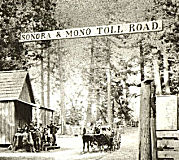 The portion of this route from Bridgeport to Route 108 (~ MNO 76.758 to MNO 94.461) was named
the "Sonora and Big Meadows Wagon Road" by Senate Bill 289 in 1901.
It was also named the "Sonora and Mono Wagon Road" by Resolution
Chapter 11 in 1901, and extended by Resolution Chapter 510 in 1919.
The portion of this route from Bridgeport to Route 108 (~ MNO 76.758 to MNO 94.461) was named
the "Sonora and Big Meadows Wagon Road" by Senate Bill 289 in 1901.
It was also named the "Sonora and Mono Wagon Road" by Resolution
Chapter 11 in 1901, and extended by Resolution Chapter 510 in 1919.
(Image source: Tuolumne County Historical Society)
 Named Structures
Named Structures There is a memorial marker at SBD 66.0 (San Bernardino County) in memory of CHP Officer
Larry J. Jaramillo. California Highway Patrol Officer Larry J.
Jaramillo died in the line of duty in a traffic collision on Route 395 at
the Kern County San Bernardino County line, while returning from court in
Inyo County on June 22, 1993. Officer Jaramillo joined the Department of
the California Highway Patrol in 1985, after successfully completing
training at the patrol academy where he received the outstanding athlete
award for his class, and, upon graduation, he reported to Morongo Basin,
as a state traffic safety officer in December 1985. In 1989, Officer
Jaramillo tested and qualified with the department to become a fixed wing
pilot and was assigned to the Inland Division Air Operations Unit
stationed in Daggett, California. On December 8, 1992, Officer Jaramillo
received the second highest award that the department may bestow, the
Special Act Award, for his rescue of two young men stranded in the
snow-covered mountains of Kern County during which Officer Jaramillo
continued his search for the young men despite warnings of adverse weather
conditions, endangering his life to continue the search until the men were
found. Memorial authorized by Assembly Concurrent Resolution 173,
Resolution Chapter 142, September 18, 2000.
There is a memorial marker at SBD 66.0 (San Bernardino County) in memory of CHP Officer
Larry J. Jaramillo. California Highway Patrol Officer Larry J.
Jaramillo died in the line of duty in a traffic collision on Route 395 at
the Kern County San Bernardino County line, while returning from court in
Inyo County on June 22, 1993. Officer Jaramillo joined the Department of
the California Highway Patrol in 1985, after successfully completing
training at the patrol academy where he received the outstanding athlete
award for his class, and, upon graduation, he reported to Morongo Basin,
as a state traffic safety officer in December 1985. In 1989, Officer
Jaramillo tested and qualified with the department to become a fixed wing
pilot and was assigned to the Inland Division Air Operations Unit
stationed in Daggett, California. On December 8, 1992, Officer Jaramillo
received the second highest award that the department may bestow, the
Special Act Award, for his rescue of two young men stranded in the
snow-covered mountains of Kern County during which Officer Jaramillo
continued his search for the young men despite warnings of adverse weather
conditions, endangering his life to continue the search until the men were
found. Memorial authorized by Assembly Concurrent Resolution 173,
Resolution Chapter 142, September 18, 2000.
(Image source: Calif. Assn of Highway Patrolmen)
This route also has the following Safety Roadside Rest Areas:
 National Trails
National Trails The portion of this segment between Route 14 and US 6 was
part of the "Midland Trail.
The portion of this segment between Route 14 and US 6 was
part of the "Midland Trail.
 Business Routes
Business Routes Scenic Route
Scenic Route Freeway
Freeway[SHC 253.8] Entire portion.
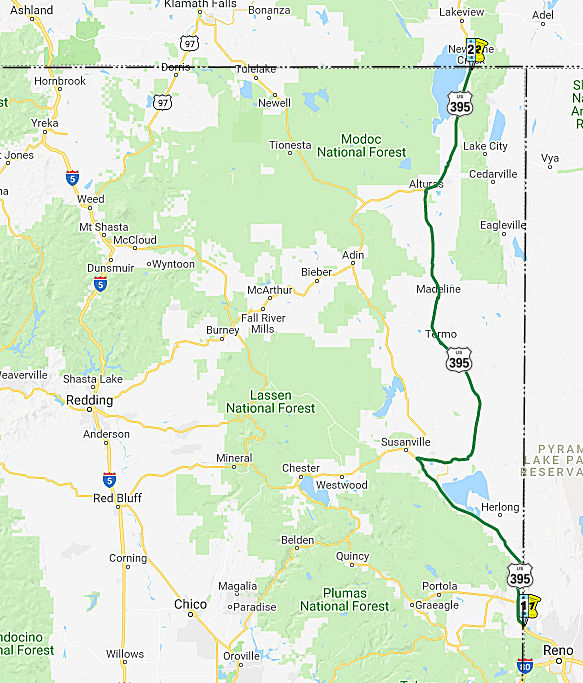 From the Nevada state line northwest of Reno to to the Oregon state line near
New Pine Creek via Alturas.
From the Nevada state line northwest of Reno to to the Oregon state line near
New Pine Creek via Alturas.
 Post 1964 Signage History
Post 1964 Signage HistoryThis segment remains as defined in 1963 as the original (c).
The portion of this route between Alturas and a point 6 mi W (i.e., between the two US 395/Route 299 junctions) is cosigned as US 395/Route 299, although it is legislatively US 395.
 Pre 1964 Signage History
Pre 1964 Signage HistoryThe segment from the Nevada state line northwest of Reno to Route 36 near Johnstonville (Susanville) was part of LRN 29, and was signed as US 395. It was a 1919 extension of the 1909 LRN 29, which ran as (signed) Route 36 between Red Bluff and Susanville (in 1933, LRN 29 was extended further to run, still as Route 36, between Route 3/Route 36 [LRN 35] to US 99 [LRN 3]).
The segment from Alturas to the California-Oregon state line near New River was LRN 73, added in 1931. This was also signed as US 395. California Highways and Public Works, April 1931, noted that the justification for the addition what that it established a connection between the Oregon State Highway System and the Redding-Alturas lateral ([LRN 28]) of the California State Highway System. The project was considered a necessary link on an east of the Sierras routing. It was a designated Federal aid route. It had been recommended for inclusion in the State highway system by the Highway Advisory Board in 1925. At the time, Oregon was improving its roads from Klamath Falls, from Bend and from Burns territory (the Yellowstone cut-off) to the state line at New Pine Creek Oregon, with State and Federal funds, and had practically completed a surfaced road from the Columbia River and also from Klamath Falls to New Pine Creek. As of 1931, the unimproved condition of the California extension was withholding from the public the potential value of these routes. Within California the project will coordinate with the Redding-Alturas highway, and through the Alturas-Susanville route, with the Red Bluff - Susanville - Reno lateral [LRN 29]. There was also a contemplated connection from Lake Almanor to the Feather River road that would extend recreational traffic further south. The route qualified as an interstate connection, as the 1931 California Highway system lacked a connection to eastern Oregon.
The last segment addition occured in 1933, and was the segment between Susanville and Alturas (more formally, between LRN 29 (Route 36/US 395) and LRN 28 (Route 299)).
In 1954, Sign Route 24 was either co-signed or resigned as Alt US 40 (US 40A). The article announcing the designation indicated that existing signs
would be replaced by US 40 signs with the designation "Alt". The article
indicated that for the first 10 miles N, from US 40 in Solano County, the
new alternate route would be designated as US 99W and US 40A. A new
section of highway was being constructed to intersect with the existing US 99W at the Woodland Wye. This would be the segment that is now Route 113.
In Woodland, US40A joined with the existing US 99W / Sign Route 24 to Yuba
City; this is now Route 113. US 40A then followed Sign Route 24 (now Route 70) through Oroville and Quincy to US 395. Lastly, US 40A followed US 395
S to Reno, which was the eastern terminus of US 40A. The goal here was to
provide an alternate route across the Sierras when Donner Pass was closed.
(Source: Roseville Press-Tribune 3/23/1954 via Joel Windmiller
(email), 11/12/2023)
 Status
StatusCurrently built to expressway standards for a stretch of 8 miles between the Nevada Border and Route 70.
At the end of May 2017, it was reported that Caltrans Dictrict 2 is developing a 20-year plan to make improvements to US 395. This process started by hosting workshops —four are planned—in cities along the road—seeking citizens’ comments. Caltrans even went so far as to bring homemade brownies (something that is above and beyond!). The workshop in Alturas was attended by 15 local residents—including elected and agency officials—was chockfull of happily-relayed comments as the group studied the road, north from near Susanville to New Pine Creek, at the California-Oregon border. In the workshop, three basic questions were asked: What works well? What works not-so-well? How can it be improved? Among improvements needed, according to the locals are:
One little bit of information eeked out—from a participant and was
augmented by Caltrans staff: There is a longstanding plan to transform the
US 395 alignment from the Arizona-Mexico border to the Washington-Canada
border into a super highway akin to I-5. It even has a name: I–11.
“Not going to happen in our lifetime,” was the general
consensus from the group. Still, the idea of a full-bore interstate
knifing through Eastern California creates wild surmise, and the Caltrans
representative will include a notation about I–11 that “the
proposal is out there” in the new report being created.
(Source: aNewsCafe.com, 5/30/2017)
Sierra / Lassen Widening
In March 2016, the CTC authorized additional funding on US 395 in Sierra and Lassen Counties, from Nevada State line (apx 395 SIE R0.0L) to one mile north of Route 70 (395 LAS R5.215). Rehabilitate pavement. This project is located in a remote location and requires significant lab and materials support. A structures maintenance review identified bridgework that was not originally in the scope, which requires additional lab support and services. In addition, there is increased support needed for the superpaving methodology. This increase is consistent with the required work for a CAPM and adds $412,000 to the cost of the project.
In August 2016, the CTC approved $11,512,000 in funding for US 395 in Sierra (PM R0.0/R3.1) and Lassen (PM R0.0/5.6) Counties, from Nevada State line to 1 mile north of Route 70; also, on Route 70 from PM 3.5 to 3.9. Outcome/Output: Rehabilitate 34.2 lane miles of pavement to extend pavement service life and improve ride quality. Project will overlay pavement, upgrade nine culverts, install approach slabs at eight locations, rehabilitate four bridges with polyester concrete overlay, install one intelligent transportation system (ITS) monitoring device, and make ADA and drainage improvements at the Agriculture Inspection Station.
In October 2017, the CTC authorized vacation of right of way in the county of Lassen along Route 395, between Janesville Grade and Lake Crest Road (02-Las-395-PM 52.3/52.6), consisting of stock trail easements no longer needed for State highway purposes.
In March 2013, the CTC provided advance authorization for $2,995,000 to rehabilitate 12.0 lane miles of roadway to improve the ride quality, prevent further deterioration of the road surface, minimize the costly roadway repairs and extend the pavement service life on the segment in and near Johnstonville, from 0.1 mile north of Sunnyside Road (apx 395 LAS 56.437) to 0.3 mile south of Route 36 (apx 395 LAS R60.693).
In May 2008, the CTC considered relinquishment of right of way in the city of Alturas, at Court Street (apx 395 MOD 22.884), East Street, East A Street, and East B Street, consisting of reconstructed and relocated city streets.
 Naming
Naming The portion of US 395
from the South Fork Pit River Bridge to a portion of the Modoc National
Wildlife Refuge (~ MOD 16.523 to MOD 20.000) in the County of Modoc is
named the "Deputy Sheriff Jack Hopkins Memorial Highway". It was
named in memory of Deputy Sheriff Jack Hopkins, who was born in Livermore,
California, in August 1985, and was named after his grandfather, Jack L.
Hopkins, who was the first mayor of Rolling Hills Estates, California.
Hopkins was raised on a cattle ranch in the rural Shasta Valley and
baptized in the Shasta River. Jack Hopkins attended Grenada and Big
Springs Elementary schools and graduated from Yreka High School in 2004.
Hopkins, who learned a great deal of discipline and respect from Mitch
Klier, of Klier’s Martial Arts, earned a black belt in karate and
won a world championship karate title in 2001. Hopkins went on to pursue
multiple associate of arts degrees at Butte College, then returned to
Butte College to attend the police academy with his older brother, Officer
Sam Hopkins, and graduated in 2013. Hopkins was known for being the type
of person whose handshake was his “word,” a happy,
good-natured guy with a great personality, and a big smile who laughed
often. Jack Hopkins began his law enforcement career with the Alturas
Police Department and transferred to the Modoc County Sheriff’s
Office. Jack Hopkins was killed in the line of duty on October 19, 2016.
Named by Assembly Concurrent Resolution (ACR) 29, 8/30/2017, Res. Chapter
130, Statutes of 2017.
The portion of US 395
from the South Fork Pit River Bridge to a portion of the Modoc National
Wildlife Refuge (~ MOD 16.523 to MOD 20.000) in the County of Modoc is
named the "Deputy Sheriff Jack Hopkins Memorial Highway". It was
named in memory of Deputy Sheriff Jack Hopkins, who was born in Livermore,
California, in August 1985, and was named after his grandfather, Jack L.
Hopkins, who was the first mayor of Rolling Hills Estates, California.
Hopkins was raised on a cattle ranch in the rural Shasta Valley and
baptized in the Shasta River. Jack Hopkins attended Grenada and Big
Springs Elementary schools and graduated from Yreka High School in 2004.
Hopkins, who learned a great deal of discipline and respect from Mitch
Klier, of Klier’s Martial Arts, earned a black belt in karate and
won a world championship karate title in 2001. Hopkins went on to pursue
multiple associate of arts degrees at Butte College, then returned to
Butte College to attend the police academy with his older brother, Officer
Sam Hopkins, and graduated in 2013. Hopkins was known for being the type
of person whose handshake was his “word,” a happy,
good-natured guy with a great personality, and a big smile who laughed
often. Jack Hopkins began his law enforcement career with the Alturas
Police Department and transferred to the Modoc County Sheriff’s
Office. Jack Hopkins was killed in the line of duty on October 19, 2016.
Named by Assembly Concurrent Resolution (ACR) 29, 8/30/2017, Res. Chapter
130, Statutes of 2017.
(Image source: KOBI-5; Girdner Funeral Chapel)
 Named Structures
Named StructuresThis route also has the following Safety Roadside Rest Areas:
I normally don't note SRRA projects, but this one is interesting as
the SRRA is being relocated. In January 2024, Caltrans released the
draft 2024 SHOPP, which contained the following project: 02-Lassen-395
103.6 /103.9. PPNO 02-3734; ProjID 0219000016; EA 4H740. US 395 Near
Ravendale, from 4.8 miles south to 4.5 miles south of School House
Road; also at Secret Valley Safety Roadside Rest Area (SRRA) (PM
96.5); also at various locations on Route 395 in Lassen and Modoc
Counties. Remove existing Secret Valley SRRA and construct at a new
location, and upgrade rest area signs at various locations.. Proposed
($ × 1000): PA&ED: $1,200; PS&E: $1,500; R/W $84; R/W Sup
$170; Con $10,700; Con Sup: $1,700; Total: $15,354. Begin Con:
5/30/2028.
(Source: 2024 Draft SHOPP v4.0, 1/31/2024)
 Freeway
Freeway[SHC 253.8] From the Nevada state line northwest of Reno to Route 36 near Johnstonville and from Route 36 near Termo to the Oregon state line.
 Historical Route
Historical RouteAs of March 2008, the California Transportation Committee unanimously approved the designation of former US 395 as a historic route from San Diego to the Oregon border. It is still pending approval by the legislature and the governor. However, anticipating approval, San Diego County Supervisor Bill Horn approved $4,000 for the 31 signs that now mark old 395 in his district -- from Vista to the Bonsall Bridge, through downtown Fallbrook, to Rainbow.
On July 8, 2008, Resolution Chapter 79 officially designated specified sections of former US Highway Route 395 as Historic US Highway 395. The resolution noted that former US 395 was a scenic stretch of highway that ran through historic areas of the County of Riverside and provided the only direct route from San Diego to the Lake Tahoe region and northern Nevada, before heading back into California on its way north to Oregon and all the way into Canada. While former US 395 remains largely intact through the Counties of Inyo, Mono, Sierra, Lassen, and Modoc, only sections of former US 395 still exist in portions of the County of San Diego and the high desert area of the County of San Bernardino; most of the former highway route has been replaced by I-15 and I-215 in the Counties of San Diego, Riverside, and San Bernardino. US 395, which remains as I-15 and I-215, was the major and most significant connection between San Diego, the Inland Empire, and the eastern Sierra Nevada region. US 395 was known as the Cabrillo Parkway (and later the Cabrillo Freeway) in San Diego, now Route 163, it was the first freeway to be constructed in San Diego and opened to traffic in 1948. Part of the original routing of former US 395 in northern San Diego County includes the old Bonsall Bridge, one of the earliest automotive crossings over the San Luis Rey River, later becoming part of Route 76. The portion of former US 395 between Temecula and Lake Elsinore was part of the Butterfield Overland Mail route, the first major overland delivery service to southern California, established September 16, 1858. After its realignment eastward, former US 395 became the first major expressway and freeway system in the southern portion of the County of Riverside in the early 1950s, servicing the Cities of Temecula, Murrieta, Menifee, Sun City, and Perris. Today this is I-215. The portion of former US 395 between the Cities of San Bernardino and Hesperia, near modern US 395, traverses the Cajon Pass with old US 66 and old US 91, most famously used by the Mormons in 1851 in their crossing into the valley where they subsequently founded the modern Cities of San Bernardino and Riverside. The heritage in the regions through which former US 395 passed was greatly diminished when the former highway was replaced by suburban streets and I-15 and I-215.The Legislature hereby recognizes the remaining segments of US 395 for their historical significance and importance in the development of California, and designates those segments as Historic State Highway Route 395. Named by Assembly Concurrent Resolution (ACR) 98, Resolution Chapter 79, on 7/3/2008.
In January 2016, it was noted that more cities were signing historic US 395. Moreno Valley will be the latest Inland city, joining others from
Riverside to Temecula, to rediscover the US 395 and put up brown signs
along the route of the once-vital artery. The city and Moreno Valley
Historical Society dedicated the 2-mile section of the 395 between
Eucalyptus and Cactus avenues on Memorial Day with a weekend of
activities. Though US 66, another U.S. highway, is considered the mother
road connecting the nation east to west, the 395 is its lesser-known
north-south counterpart. The 1,400-mile road was known as the Three Flag
Highway because it went from the Mexican border through several Western
states to the Canadian border, said Jeffery Harmon, founder of the
Historic Route 395 Association. It was officially designated U.S. Highway
395 in 1939 after passage of federal legislation. However, it had existed
as a series of dirt roads from San Diego to the Cajon Pass for decades.
During World War II, at the urging of the military, the highway was
improved to provide a better link between San Diego’s Navy base, a
weapons depot in Fallbrook and March Field in what later became Moreno
Valley. The route was nicknamed the Cannonball Highway because of its
military importance. The highway faded into obscurity after years of
rerouting and the development of other north-south routes, I-15 and I-15E
(now I-215), in the 1970s. By the 1980s, US 395 had been decommissioned in
Riverside and San Diego counties, though it continues to run from Hesperia
in San Bernardino County along the eastern Sierra Nevada and north to
Canada. In recent years, several cities have begun efforts to commemorate
US 395. In San Diego and other cities in San Diego County, signs were put
up along the route. Communities such as Fallbrook, Rainbow, Temecula,
Murrieta, Lake Elsinore, Perris and Riverside did the same. In Riverside,
city officials put up 36 signs on downtown streets, including Market
Street and University Avenue, which still has roadside hotels that are a
remnant of when it was part of the highway, said Steve Lech, president of
the Riverside Historical Society.
(Source: Press-Enterprise, via AAroads)
ACR 26 requested the Department of Transportation, upon application by an interested local agency or private entity, to identify any section of former U.S. Highway Route 6 that is still a publicly maintained highway and that is of interest to the applicant, and to designate that section as Historic U.S. Highway Route 6. Chaptered July 3, 2007. Resolution Chapter 67.
 National Trails
National Trails All of original US 395 (i.e., current Route 395 plus parts
of I-15, I-215, and Route 163) was part of the "Three Flags Highway".
All of original US 395 (i.e., current Route 395 plus parts
of I-15, I-215, and Route 163) was part of the "Three Flags Highway".
 Exit Information
Exit Information Other WWW Links
Other WWW Links Blue Star Memorial Highway
Blue Star Memorial HighwayThis route (post-1964 US 395) was designated as a "Blue Star Memorial Highway" by Assembly Concurrent Resolution 112, Ch. 143 in 1984.
 Statistics
StatisticsOverall statistics for US 395:
© 1996-2020 Daniel P. Faigin.
Maintained by: Daniel P. Faigin
<webmaster@cahighways.org>.